Anniversary of Russia’s invasion of Ukraine closes with China entering the diplomatic fray
That wraps up the Financial Times’s live coverage of the first anniversary of the war in Ukraine.
Today, China announced a peace plan that was viewed sceptically by EU and NATO leaders, but welcomed by Ukrainian president Volodymyr Zelenskyy.
The World Bank announced an additional $2.5bn in grant financing to Ukraine, bringing the bank’s total assistance to the country to more than $20bn since Russia’s invasion.
Japan’s prime minister Fumio Kishida said the G7 group of nations was planning to bring new sanctions against Russia, while the US took aim at Russian banks and defence companies with its own set of new curbs.
In his anniversary remarks, Zelenskyy vowed to defeat Russia in 2023.
“Our victory is inevitable. It is close. It will happen,” he said.
Scenes from Ukraine: Nikopol
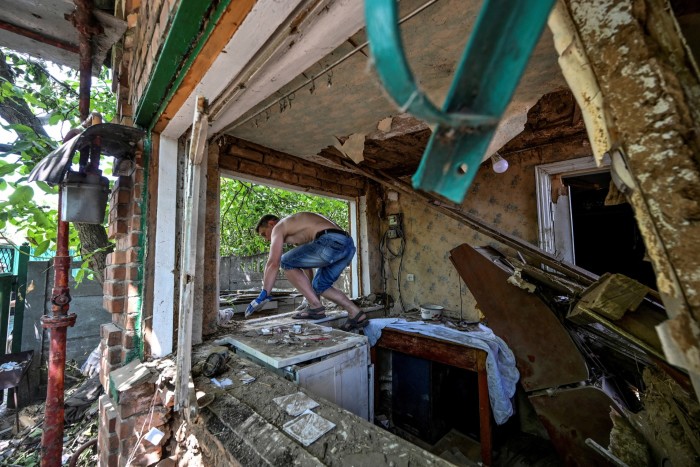
Mykhailo Poperechnyuk assured us the guns were far enough away. We were eating pizza in the central square of Nikopol last July, a down-at-heel industrial town on the banks of the Dnipro river in southern Ukraine. It was baking hot. Artillery fire rumbled in the distance. An air raid siren blasted out from the roof of the nearby town hall.
Russian forces were only 5km away across the river, where they had taken up positions within the perimeter of the Zaporizhzhia nuclear power plant and were using it to fire at Ukrainian positions without the threat of returning Ukrainian fire. But, Poperechnyuk promised, Russian rockets were only fired at Nikopol during the night. It was a way of terrorising and tiring out the rapidly diminishing local population, he said.
Poperechnyuk is the embodiment of Ukraine’s energetic civic resilience: an entrepreneur, charity worker, local politician and territorial defence member with a muscular frame and permanent smile. He showed us around his town: the compound where his charity hands out food parcels and medicine; the Soviet-era housing blocks smashed by Russian missiles; and the beach club, where locals bathed incongruously in the Dnipro’s dark green waters a short distance from Russian positions.
Nikopol has been battered by hundreds of rockets since our visit last summer. Most of the 100,000 residents have now fled. But it’s still in Ukrainian hands. And it still needs Poperechnyuk’s help.
Key dates in the war — January 25 2023
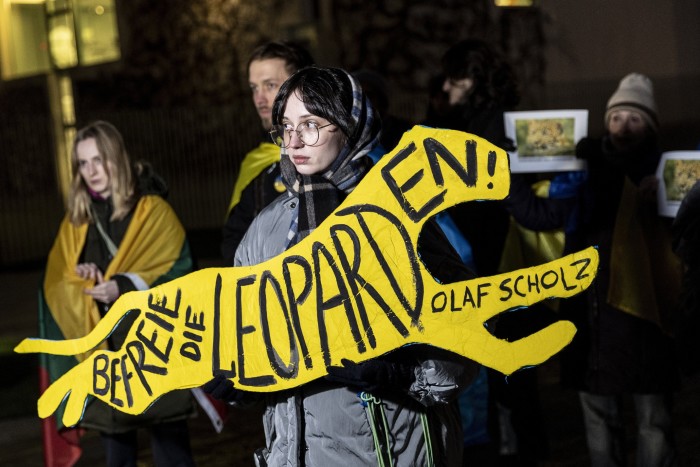
German chancellor Olaf Scholz agrees to send Leopard 2 tanks to Ukraine, a big step up in western military support.
Bond yields surged as war complicated central banks’ fight against inflation
Interest rates across the globe are at their highest levels in years 12 months after the Russian invasion of Ukraine, as global central banks struggle to rein in inflation driven up by the boom in commodity prices.
Inflation was already elevated in February 2022, as prices were pushed higher by snarls in supply chains and the enormous fiscal stimulus unleashed to temper the worst effects of the Covid-19 pandemic. But those inflationary forces had been described by central banks as transitory — the temporary effects of the pandemic economy.
The sanctions placed on Russia at the start of the war caused the prices of oil, gas and coal — among other commodities — to rocket, entrenching already high and rising inflation. Even as supply chains were unblocked and pandemic cash was spent, inflation continued to rise.
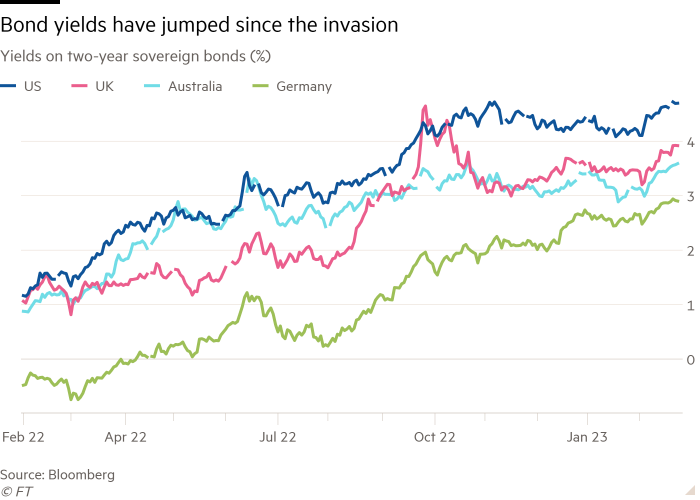
The persistence of that inflation has forced central banks to raise interest rates higher still, lifting yields on government debt. Two-year sovereign bond yields, which move with interest rates, have risen more than 2 percentage points in Germany, the UK, the US and Australia, among others, in the past year alone. As the cost to borrow has risen for sovereign nations, so it has for companies, pushing corporate bond yields higher and stock prices lower.
There is little chance they will fall soon. Although inflation globally has begun to slow, the pace remains far above target for many central banks, which have vowed to continue their fight.
Nearly 300,000 Ukrainians have settled in the US since the war began
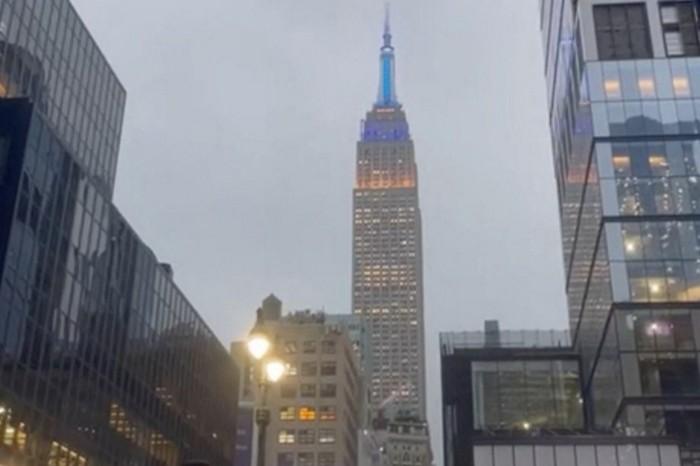
Russia’s full-scale invasion of Ukraine forced millions of its citizens to flee the country. While many have found new homes in Europe, nearly 300,000 Ukrainians have arrived in the US since the war began.
According to US Citizenship and Immigration Services, the country has welcomed more than 271,000 Ukrainians since March. They have entered the country through a variety of pathways, from private sponsorship to visas, or applying as refugees. Nearly 150,000 have arrived via the United for Ukraine program under the Department of Homeland Security, which launched in April 2022.
“DHS continues to honour the president’s commitment to Ukrainians fleeing Russia’s unprovoked war,” an agency spokesperson said. “DHS remains committed to supporting Ukrainians in the United States, and we continue to explore opportunities to provide avenues for humanitarian relief and protection.”
More than 200,000 Americans have signed up to financially support Ukrainian arrivals, with 15 per cent of applications to support migrants coming from the New York City metropolitan area, which extends into New Jersey. That is closely followed by the Chicago metropolitan area, which received 12 per cent of applications.
Most people in the US with Ukrainian ancestry live in New York or Pennsylvania. A spokesperson for the government of Pennsylvania told the Financial Times that about 12,000 people have arrived in the state from Ukraine via the United for Ukraine programme.
Key dates in the war: December 21 2022
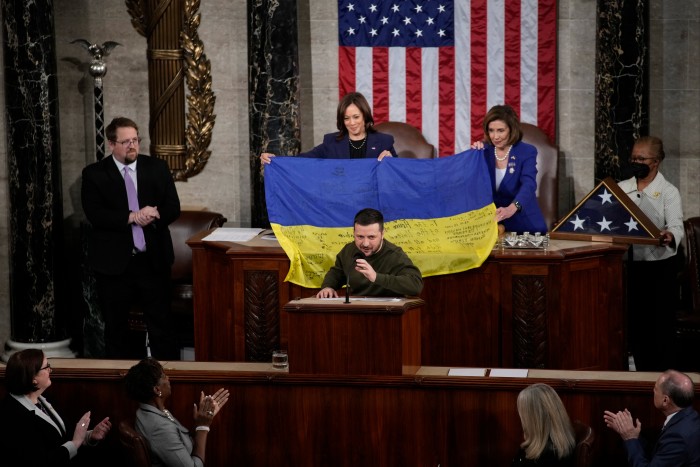
Ukrainian president Volodymyr Zelenskyy makes a surprise visit to the US, his first trip outside the country since the start of the war. “Your support is crucial not just to stand in such a fight, but to get to the turning point to win on the battlefield,” he said in a speech to Congress. “Your money is not charity, it’s an investment in the global security and democracy that we handle in the most responsible way.”
Coal prices are back to normal after a summer surge
One year on from Russia’s invasion of Ukraine, the price of thermal coal has fallen back to prewar levels after a dizzying climb that broke records and changed expectations for a fuel long thought to be in decline.
Although Russia is far from the world’s biggest coal producer, it has an outsized impact on global coal markets because much of its coal is traded internationally on the seaborne market. Europe was a big customer, drawing 70 per cent of its coal imports from Russia prior to the war.
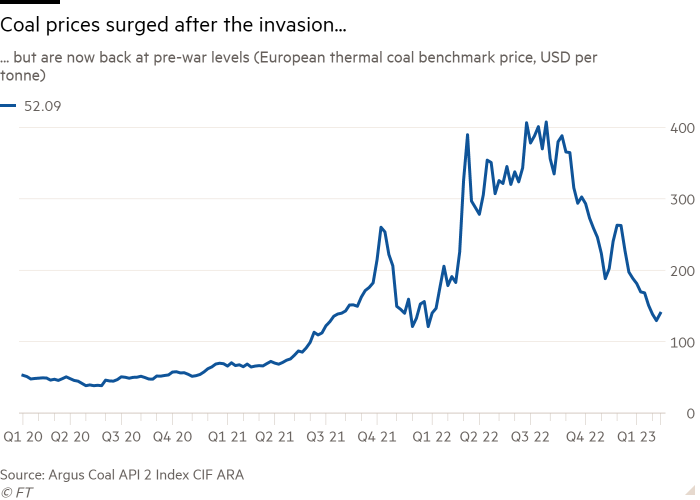
After the invasion, Europe’s ban on Russian coal imports led to a scramble for replacement supplies around the globe. Coal markets struggled to meet this new demand from Europe, causing prices to triple by the summer, compared with their level at the start of the year.
Now the situation has eased, as mild winter weather in Europe has allowed the region to avoid a severe energy crisis, and left coal stockpiles relatively untouched.
In the Antwerp-Rotterdam-Amsterdam region, coal stocks now stand at about 6mn tonnes, double the level of this time last year, says Alex Thackrah, head of coal pricing at Argus Media.
“Coal-fired power generation in Europe this winter was not as high as expected,” said Thackrah. The coal market is easing at the moment, but it’s not clear if that will continue into the second half of this year. “The risk of a crisis is next winter.”
Russia’s economy under fresh pressure as military spending rises
Record oil and gas profits helped to prop up Russia’s output in 2022, confounding economists who had predicted a drastic fall as western sanctions took hold and Moscow’s coffers were drained by its military mission in Ukraine.
Energy profits of Rbs11.6tn ($168bn) helped the Kremlin compensate for western efforts to shut Russia out of global markets and supply chains — a result that president Vladimir Putin proudly celebrated in January. GDP slipped just 2.1 per cent versus Russian economists’ forecasts of 10-20 per cent.
But Russia’s budget deficit is expected to rise to 3.5 per cent of GDP in 2023, according to analysis published on Friday from the European ratings agency Scope — far higher than Moscow’s forecast of 2 per cent.
Income from energy — which accounts for about 40 per cent of government revenue — is falling and is expected to drop 23 per cent this year as the west looks to put a price cap on its oil exports. Military spending, meanwhile, has ballooned.
To compensate for the increase in defence spending — which now accounts for a third of all budget spending approved for 2023 — the Kremlin has been preparing to cut its fiscal expenditure and reliance on international capital markets.
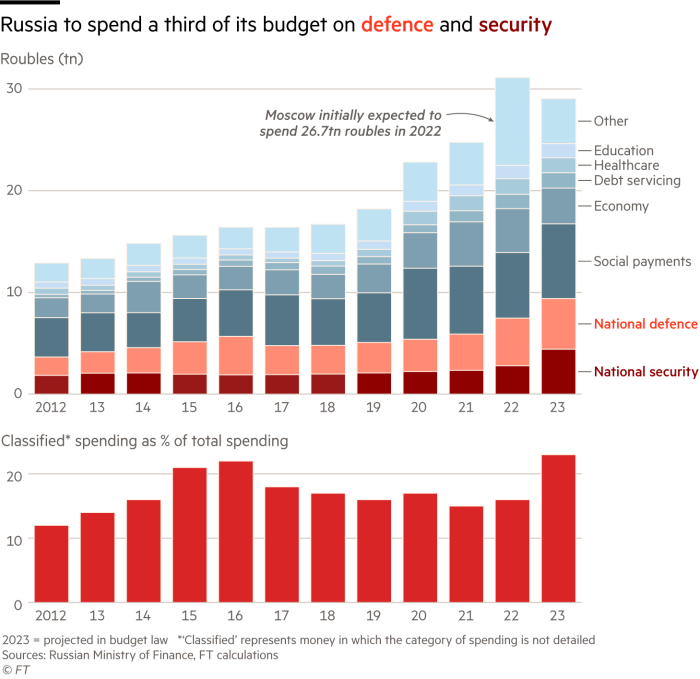
Russia’s National Wealth Fund has shrunk $19bn since the start of the invasion, falling to 7.2 per cent of GDP against 10.2 per cent a year ago. Rather than deplete the fund further, Russia is likely to turn to debt markets, particularly its state-owned banks.
Windfall taxes are also on the table; last year it levied $20bn on energy company Gazprom. The Kremlin’s economic cabinet is also discussing a “voluntary contribution” from major Russian companies, the first deputy prime minister, Andrei Belousov, said in February.
Key dates in the war: April 2022 - February 2023
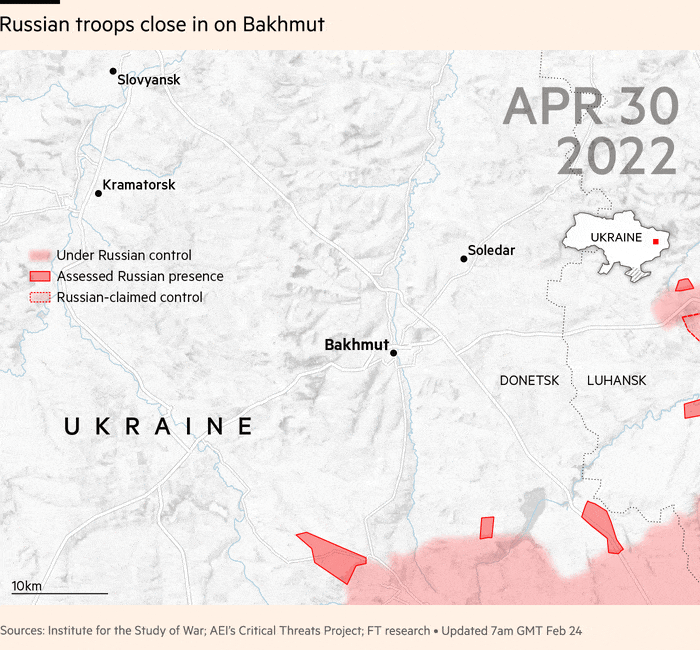
Russian troops close in slowly on the city of Bakhmut in the east of Ukraine.
China’s peace plan is proably headed nowhere
China’s decision to launch a peace plan for Ukraine is a reflection of the delicate tightrope Beijing is walking over the war.
For most Chinese delegates, last week’s Munich Security Conference, was the first trip to Europe they have made since the beginning of the pandemic. They were taken aback by how much opinion has shifted against China in Europe over the past couple of years. The announcement of a “no limits” partnership between China and Russia was a PR disaster for Beijing in Europe.
Beijing has long feared that the US will persuade its European allies to join in efforts to contain China economically and militarily. And, to judge by the atmosphere in Munich, the Chinese have reason to be concerned.
The Chinese peace plan is an effort to recast Beijing’s image as a neutral and constructive player on Ukraine. It may attract some positive publicity in the Global South. And there will be a few voices in Europe that may be willing to give it a try — such as the German president, Franz-Walter Steinmeier.
But, in general, the European reaction is likely to be suspicion. The consensus view within Nato is that a ceasefire now would freeze Russian gains in place — and that Ukraine must be allowed to fight on. The Russians themselves show no sign of being interested in a ceasefire.
So, for now, the Chinese plan is probably going nowhere.
Key dates in the war: November 11 2022
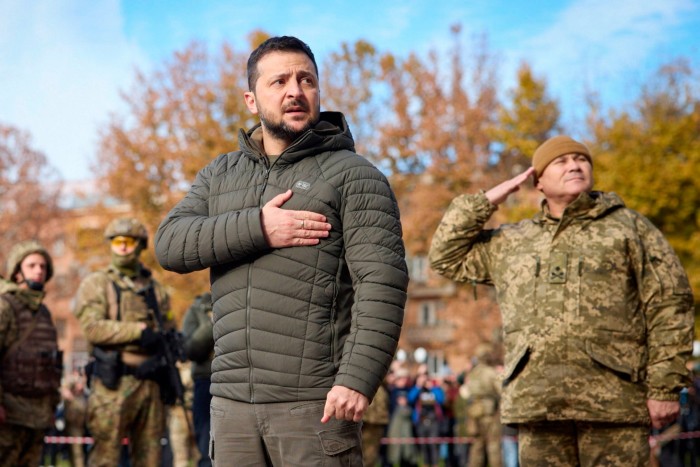
Ukraine retakes the crucial southern city of Kherson after Russia withdraws. “Is it the beginning of the end of the war? Of course . . . we are step by step coming to the temporarily occupied territories,” said Volodymyr Zelenskyy in Kherson’s main square a few days later. “[But] it’s a long way, it’s a difficult way.”
Nickel market still beset by low liquidity one year on from start of war
Fears of sanctions on large nickel producer Russia sparked a trading fiasco last March that was so severe that it posed systemic risk to global financial markets.
The Russia-related market panic collided with a bet on falling prices by China’s Tsingshan, the world’s largest stainless steel manufacturer and nickel producer. That led nickel prices on the London Metal Exchange to more than treble in a matter of days to a record above $100,000 per tonne.
That prompted the 146-year-old exchange to suspend and cancel billions of dollars worth of trade, sparking a near $500mn legal dispute with hedge fund Elliott Management and market maker Jane Street.
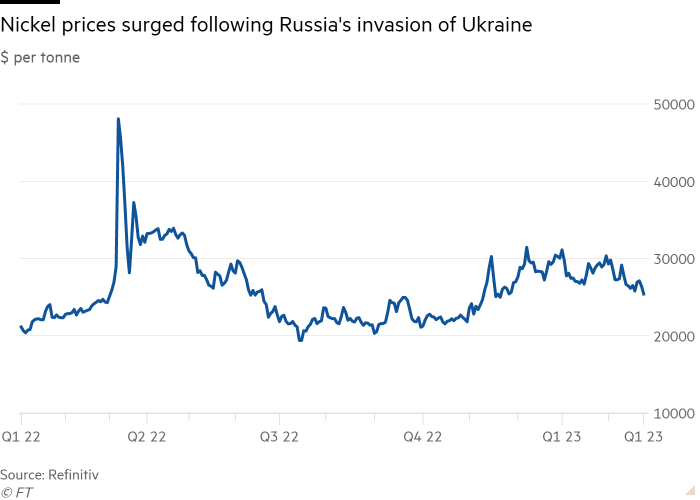
Russia is the world’s third-largest producer of nickel, the metal used in steelmaking and electric car batteries. Yet no sanctions have been placed on Russian nickel by western governments to date, partly because Russia’s largest nickel supplier, Norilsk Nickel, also generates 40 per cent of the world’s palladium, a key component in catalytic converters in cars.
Even so, one year on, the crisis is still being felt. Trading volumes on the LME nickel contract, which serves as the global benchmark price, have been suffering from low liquidity. As such, producers, traders and industrial consumers lack a reliable mechanism to hedge against movements in price.
The LME is trying to restore faith in the nickel market, deciding on Thursday to reopen trading during Asian hours from March 20. It expects the move will restore liquidity, but conditions still remain some way off resembling a functioning market.
Scenes from Ukraine: Flags on Kyiv’s Independence Square
In the first months after Russia’s full-scale invasion of Ukraine, a touching and simple war memorial sprang up on a lawn alongside Kyiv’s Independence Square.
Small Ukrainian flags were planted on a grassy embankment, some with names scrawled on them to remember those “killed by Putin”, in the words of a makeshift wooden sign at the site. When I first glimpsed it last April, there were a few dozen flags; now there are thousands.
Flags commemorating 🇺🇦 people who have lost their lives in the 🇷🇺 invasion of 🇺🇦. Last Summer there was a handful. Now you can barely see the grass. pic.twitter.com/3hpwvCAv4X
— Dame Melinda Simmons (@MelSimmonsFCDO) February 17, 2023
“It’s a pretty big yard, but the front bank is completely full,” Ryan Routh, an American volunteer who started the memorial last year, said. “There may be 10,000 at this point. ‘Flags of the fallen’ is what I’ve been calling it.”
Routh, a former construction worker who lives in Hawaii, is one of the thousands of foreigners who, after seeing news reports about the invasion, travelled into Ukraine in early 2022 to volunteer as fighters or medics.
Aged 56, he was told he was too old to fight and instead set up a tent on the Maidan to help co-ordinate foreign volunteers, then the flag memorial too.
As of February 13, the Office of the UN High Commissioner for Human Rights said it had verified 7,199 civilian deaths and more than 11,000 injured during the invasion, but the UNHCR also notes that the real numbers could be higher.
Routh says he is still active in helping to recruit foreign volunteers so this war “doesn’t drag on for years”.
Key dates in the war: October 8 2022
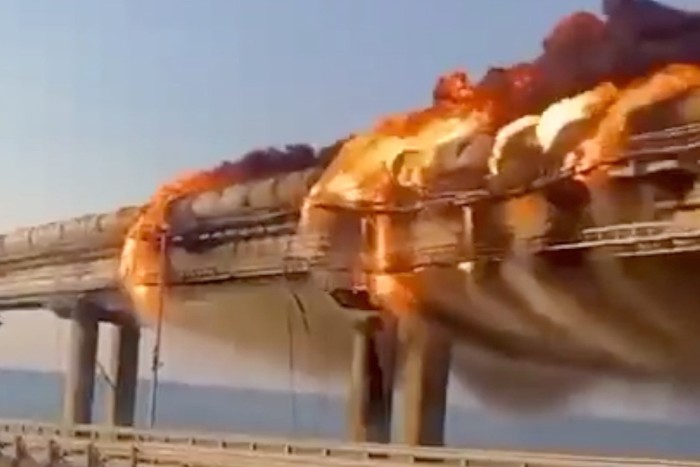
An explosion rips through a crucial bridge connecting the annexed peninsula of Crimea to the Russian mainland. The apparent attack sent two of the Kerch Bridge’s road spans crashing into the sea and set a nearby railway shipment of fuel tanks ablaze, halting all traffic on the route which the Russian military relies on to ship supplies and equipment into the war zone in southern Ukraine.
Things to watch out for on battlefields in coming months
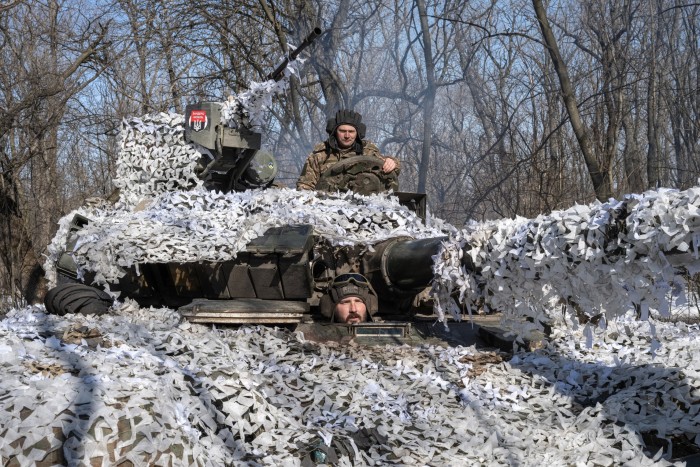
Here are three things to watch out for over the coming months on the battlefields of Ukraine
China: Will it start to supply military aid to Russia? NATO chief Jens Stoltenberg was just the latest western official to warn on Wednesday that Beijing “may be planning to provide lethal support for Russia’s war”. If it did, that could be a game-changer. On the battlefield, it could mean that Russian forces would have more modern military equipment. It would also open the question of the west’s response. Hefty western sanctions against China would have global, economic effects.
Force ratios: If Russia commits to a major offensive over spring, will Ukraine be able to hold the frontline without committing fresh troops from reserves? If it cannot, that could weaken Kyiv’s own spring offensive. If it can, that increases the chances of a successful Ukrainian counter offensive that pushes Russian troops back — perhaps even out of the country.
Western military aid to Ukraine: Currently, there is no sign that western support is flagging — on the contrary. But will that military aid, especially artillery ammunition, start to flow more quickly to Ukraine and in the volumes that Kyiv needs? Both sides are suffering ammunition shortages. So more western ammunition, delivered more quickly to Ukraine’s front lines, could make a major difference.
Protesters march to the Russian embassy in London
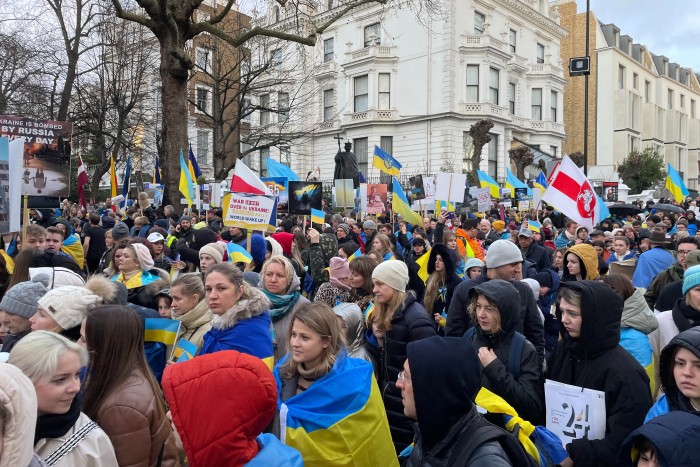
Over a thousand people marched in solidarity with Ukraine towards the Russian embassy in London on Friday as they protested against Russia’s invasion on its one year anniversary.
Ukraine’s ambassador to the UK, Vadym Prystaiko said the march would remind Russia of “the very short lives” taken in the war as he thanked attendees and “all nations standing with us.”
“I welcome everybody to Ukraine to help us rebuild this nation, our Ukraine,” he told the crowd that gathered by a statue of St. Volodymyr, the patron saint of Kyiv.
Beneath the statue, UK minister of faith Baroness Scott of Bybrook laid a wreath dedicated to “the 461 children who have perished” in the past year.
The demonstration brought together supporters chanting for “more sanctions for Russia” and “more weapons for Ukraine” as they waved flags from across the world including Poland, Latvia, Lithuania and Estonia.
Liubov Lurchuk, who moved to London from Zhytomyr in western Ukraine 12 years ago, recalls feeling “scared and shocked” when the war broke.
“I didn’t shower and brush my teeth for three days,” Lurchuk said. “Now a year later, it’s not a shock anymore but it’s no less pain.”
Russia’s currency has recovered from a post-invasion low
The rouble’s value against the dollar has barely budged a year on from Russia’s full-scale invasion of Ukraine, though there have been plenty of twists and turns along the way.
The rouble tumbled to 150 — a record low — from 75 against the dollar in the month after Vladimir Putin ordered troops into Ukraine, despite Russia’s central bank more than doubling interest rates to 20 per cent in late February.
European and US sanctions designed to cut Russia out of the global payments system and freeze the central bank’s assets swiftly followed. In late March, an emboldened Joe Biden declared the rouble had been “reduced to rubble” as a result.
Then came the rebound. Moscow’s imposition of capital controls meant the rouble had recovered almost all of its losses by the start of April. The currency was also helped by the continued flow of revenues from exports of oil and gas.
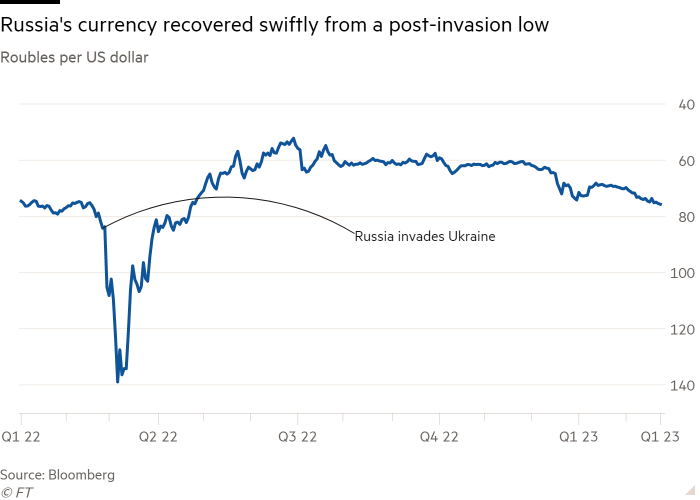
The rouble was briefly the world’s best-performing currency by May, but it has gradually weakened since July. Today it trades at 76.
Key dates in the war: July 3 2022
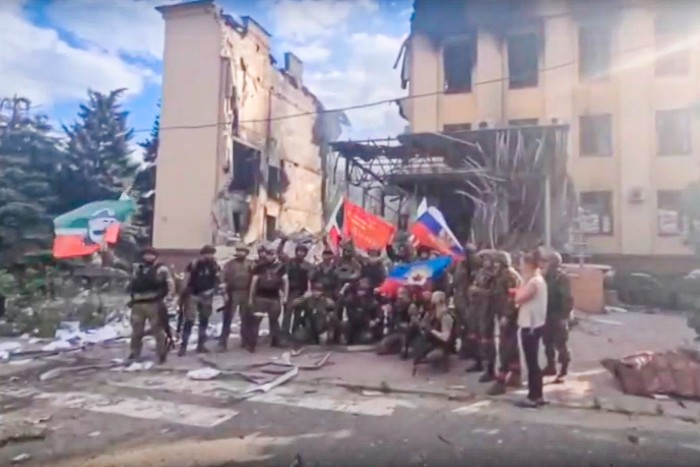
Russia claims full control of the Luhansk region in the east of the country after weeks of brutal fighting culminating in the capture of the city of Lysychansk. It was the first big victory for Moscow since the initial invasion. Two months later, Vladimir Putin announced the annexation of four Ukrainian regions.
Cakes in Kyiv: How UK politicians have made their mark
For some in the British government, the strength and depth of bilateral ties with Ukraine, and the commitment to supporting its war effort, is a vindication of their vision for how a post-Brexit UK will operate within Europe.
Britain’s vote to quit the EU has done significant damage to the country’s standing elsewhere: one of the big challenges that the Conservatives faced when Joe Biden was elected president was convincing his aides that they weren’t a continuation of the Trump presidency just with different accents.
The country’s response not only to the war but its build-up, and the supply of British arms to Ukraine, cannot change the widespread perception that the UK is a country with deep domestic problems that is committed to a course of action that allies regard with some perplexity.
But it has meant there is something to say about the UK and its place in the world other than Brexit or its self-inflicted crises. There are cakes bearing former prime minister Boris Johnson’s name on sale in Kyiv. Rishi Sunak was privately gratified to learn that there is now a cake named after him, too. (Amusingly, Liz Truss cakes have now lasted considerably longer than her premiership.)
The UK government’s main priority is to help boost Ukraine’s defences and prevent a wider crisis for Europe’s security. But it also, in the minds of some ministers, acts as a way to demonstrate that Britain still remains a committed and indispensable European ally and security partner even while remaining outside the formal structures of the EU and EEA.
Sunak backs Zelenskyy’s support for China engagement
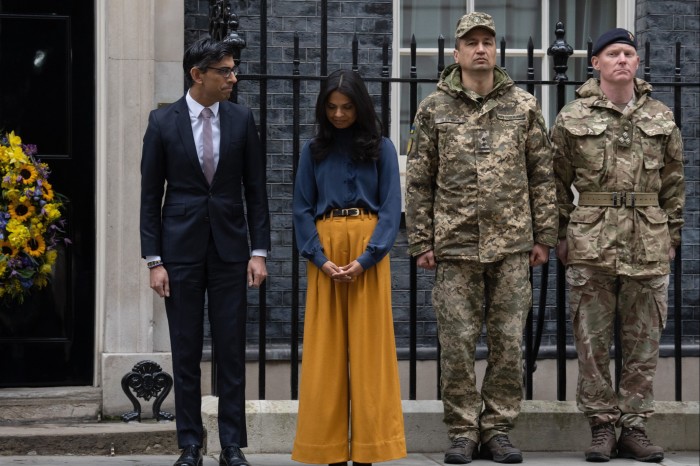
UK prime minister Rishi Sunak told his G7 group colleagues that Ukraine will continue to need military support from its allies, and that he supported China’s call for a ceasefire.
Sunak told his G7 peers that “the international community needed to support Ukraine with long term military and security assurances to send a strong message to President Putin that the global support was enduring,” according to a readout from the meeting on Friday.
Sunak also weighed in on China’s call for a ceasefire in the war, which was criticised by the heads of Nato and the European Commission because Beijing has not condemned the invasion. Ukrainian president Volodymyr Zelenskyy said he supported China’s statement, but that he hoped actions would follow its words.
“Reflecting on China’s ceasefire proposals, the Prime Minister said he supported President Zelenskyy’s calls for China to engage with Ukraine, adding that peace could only be achieved on Ukraine’s terms,” the readout said.
World Bank announces $2.5bn grant financing to Ukraine
The World Bank has announced a further $2.5bn grant financing to Ukraine on the anniversary of Russia’s invasion.
In a statement, the World Bank said the money would support a range of social functions in the war-torn country, including healthcare, education and pensions.
“One year into Russia’s invasion of Ukraine, the world continues to witness the horrific destruction inflicted on the country and its people,” said World Bank president David Malpass.
The latest grant brings the bank’s total assistance to Ukraine to more than $20bn since Russia’s invasion.
US attempts to seize $75mn of New York and Florida properties linked to Russian oligarch
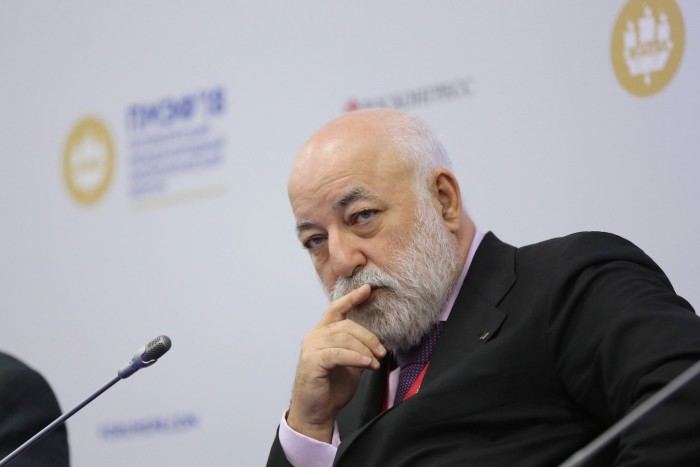
New York prosecutors have moved to seize six properties in New York and Florida, collectively worth about $75mn, which they allege are ultimately owned by the sanctioned Russian oligarch Viktor Vekselberg.
The luxury homes in the Hamptons, Manhattan and Fisher Island were bought via a series of shell companies in Panama and the Bahamas, the US government said on Friday, in an announcement coinciding with the anniversary of Russia’s invasion of Ukraine.
Vekselberg funnelled millions of dollars into the US to keep the properties maintained, prosecutors said, and even attempted to sell two of the properties.
A yacht and private plane belonging to Vekselberg — who was first sanctioned by the US in 2018, in response to the annexation of Crimea — were already seized last year.
The sanctions against Vekselberg — for “malign activities” on behalf of President Vladimir Putin’s regime — forced him to give up control of his companies and barred him from doing business with US citizens without a special licence from the Treasury.
“With the filing of this complaint, the United States sends a strong message to those who violate sanctions and engage in money laundering that the United States will use every available tool to forfeit criminal proceeds and will use that money to help our allies in Ukraine under the newly enacted law,” US attorney Damian Williams said.
A year is a long time in the gas market for Russia
The natural gas market was the canary in the mine for the war in Ukraine. In 2021 Russia quietly started squeezing supplies to Europe, pushing up prices long before the full-scale invasion.
Vladimir Putin saw Europe’s strategic weakness.
Much of the gas industry initially swallowed the Moscow-propagated excuse of production issues or the contradictory claim Europe had failed to sign enough gas deals, despite Russian supplies having grown to meet 40 per cent of the continent’s needs.
The invasion shattered the illusion that this was just a benign market hiccup. Countries that refused new demands to pay in roubles were soon cut off. Eventually Russia slashed all exports on pipelines to Poland and Germany, regardless of payment, leaving only a trickle arriving through Ukraine and Turkey.
The threat of blackouts and rationing in winter loomed.
By August European gas contracts had reached about 10 times the normal level. In oil terms, gas was trading at $500 a barrel.
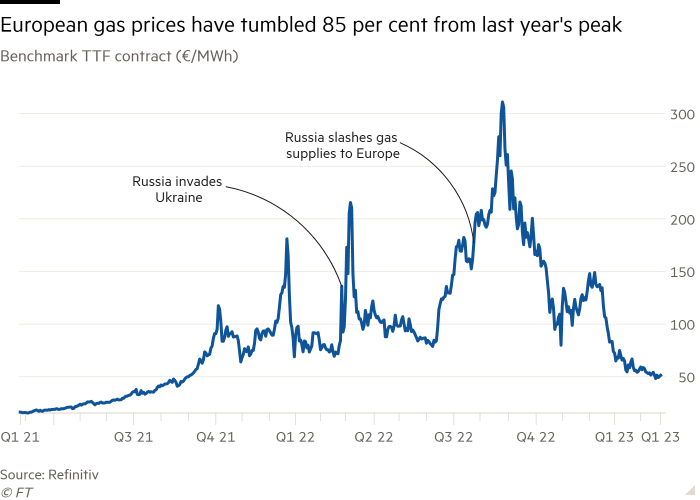
High prices ensured Europe sucked in every seaborne cargo of liquefied natural gas available. Norway boosted supplies as high as possible. Industries found ways to reduce gas consumption without losing output. By winter, against the odds, Europe’s gas storage sites were full.
Prices started to retreat. Then it became a rout. A mild start to winter kept consumption down and storage brimming. By February prices had fallen 85 per cent from their peak.
Gas remains expensive by historical standards, but prices are now at least manageable, trading in oil terms near $85 a barrel.
Republican support for US aid to Ukraine is waning
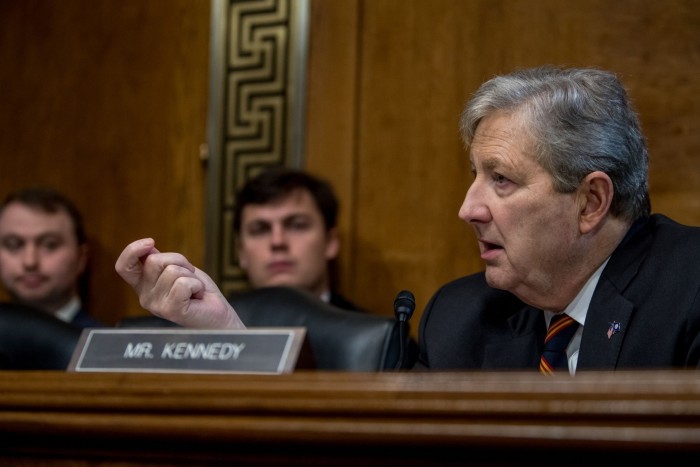
Some Republicans have become critical of the US sending billions of dollars of aid to Ukraine, and have proposed increased oversight of the funds sent abroad and even halting additional aid.
Although Republican leaders Senator Mitt Romney and Mitch McConnell support sending aid to Ukraine, nearly half of Republicans think the US is doing “too much” to help Ukraine, according to a January Gallup poll.
Pew Research said four-in-10 Republicans said the US was providing too much aid to Ukraine.
“I’ve never seen our resources as an act of charity. I think of it as an act of preservation,” said Senator John Kennedy of Louisiana in an interview he posted on Twitter on Friday. “Europe has to do more. The truth of the matter is that Europe is totally dependent on the United States of America for its defence.”
“We need to follow every American dollar,” said Kennedy, who has tried to appoint a special inspector general to oversee all US funds sent to Ukraine. “Make sure it gets to where it needs to be going and it’s not stolen.”
This month, US congressman Matt Gaetz led a group of 11 lawmakers who introduced a resolution to halt additional US military and financial aid to Ukraine.
G7 warns countries to stop supporting Russia or ‘face severe costs’
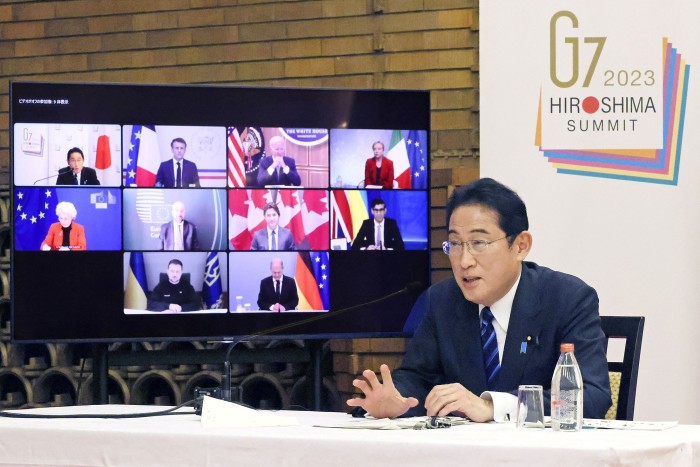
The G7 group of leading economies has warned other countries to stop supporting Russia’s war against Ukraine “or face severe costs”, following a summit held on the first anniversary of Moscow’s invasion.
“We will maintain, fully implement and expand the economic measures we have already imposed, including by preventing and responding to evasion and circumvention . . . to bolster compliance and enforcement of our measures and deny Russia the benefits of G7 economies,” G7 leaders said in a joint statement following the meeting.
“We call on third-countries or other international actors who seek to evade or undermine our measures to cease providing material support to Russia’s war, or face severe costs,” the statement added. “To deter this activity around the world, we are taking actions against third-country actors materially supporting Russia’s war in Ukraine.”
The countries also said they “commit to further aligning measures, such as transit or services bans” to prevent further evasion.
The leaders, who were joined by Ukraine’s president Volodymyr Zelenskyy, also said they “remain committed to co-ordinating efforts to meet Ukraine’s pressing military and defence equipment needs, with an immediate focus on air defence systems and capabilities, as well as necessary munitions and tanks”.
Key dates in the war: May 2022
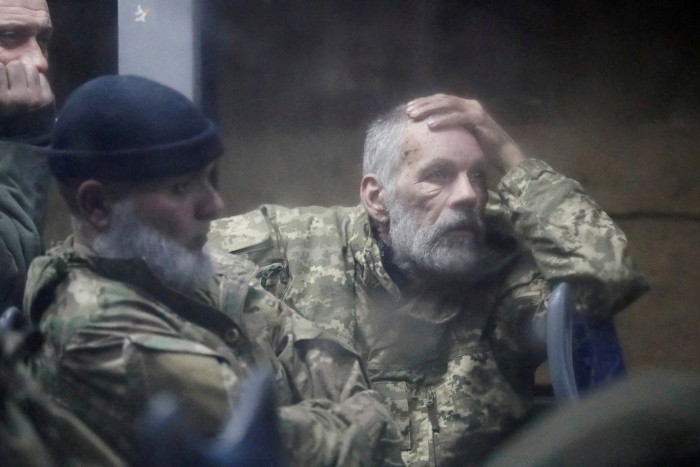
Russia crushes last-ditch Ukrainian resistance at Azovstal steel works in Mariupol, where an intense battle had been raging for weeks. Mariupol is an important port city in the south of Ukraine.
Putin has ‘failed in his primary objective to conquer,’ Blinken tells UN
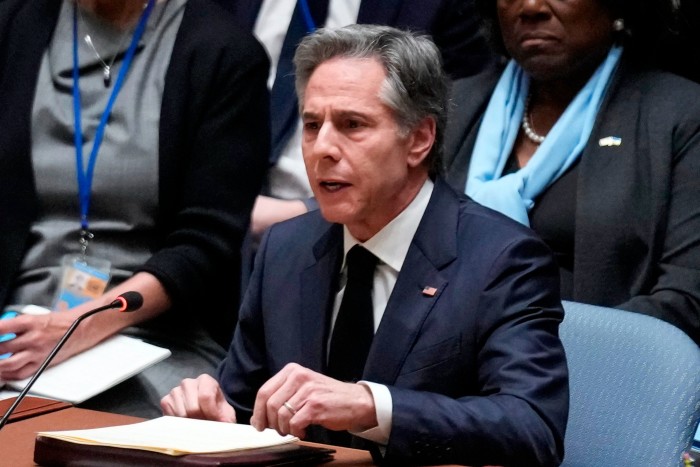
US secretary of state Antony Blinken addressed the United Nations Security Council on Friday morning, saying that one year on from Russia’s invasion of Ukraine, Vladimir Putin had “failed in his primary objective to conquer” the country.
“The spirit of Ukraine remains unbroken; if anything, it’s stronger than ever,” Blinken said as he called on the international community to stand with Ukraine and abide by the principles of the UN charter.
“If we do not defend these basic principles, we invite a world in which might makes right, the strong dominate the weak,” Blinken said as he called for allies to “push for a just and durable peace” in Ukraine.
The Security Council met in New York to discuss the maintenance of peace and security in Ukraine on the first anniversary of the full-scale Russian invasion.
The secretary of state also urged UN member states to “continue to document Russia’s war crimes and crimes against humanity, and share this evidence with investigators and prosecutors, so that one day, the perpetrators can be held accountable”.
Zelenskyy reacts to China’s latest push for peace
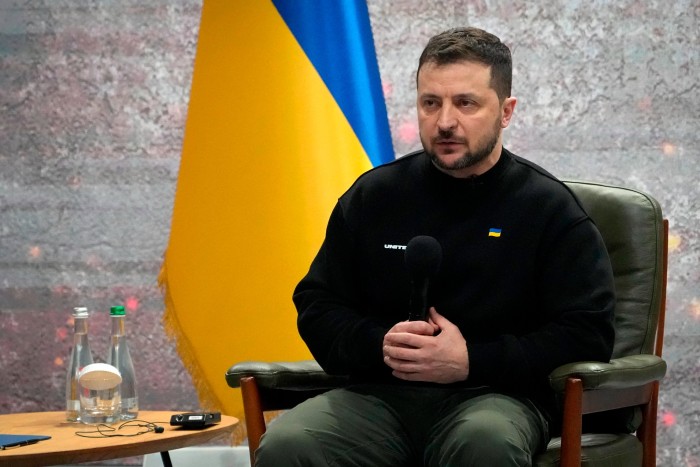
Ukrainian president Volodymyr Zelenskyy has given his first reaction to China’s latest effort to end the war.
Speaking in Kyiv, Zelenskyy welcomed China’s involvement but added that much would depend on details and implementation.
“I don’t think that was China’s peace plan,” he said. “It was not a declaration or resolution. I think that China spoke its mind about the matter and I actually said it once before — China talking about Ukraine . . . is a good thing.”
“But it begs the question, what will these words be followed with?”
“There are some things that make sense to me and some that I disagree with, that the entire world disagrees with, I think,” he added.
“Our task is to get everyone together to isolate Russia.”
Zelenskyy said he is hopeful that China will side with Ukraine and its allies, rather than supporting Russia.
“We came up with a peace formula. I think it was an important signal that China looks like it’s going to participate in it,” he said.
“I want to believe that China is not going to provide weapons to Russia. I’m doing my best to prevent that from happening. It’s very important for us. It’s better the way things are for China now than in Russia’s embrace, because there’s this risk of the third world war.”
Mitch McConnell says aiding Ukraine is not an act of ‘charity’
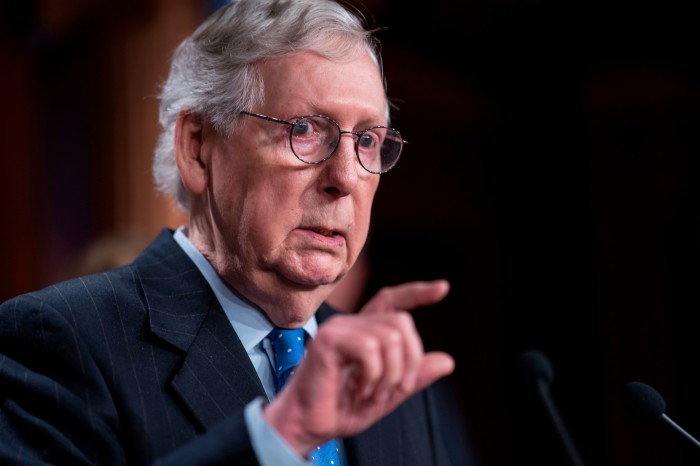
Mitch McConnell, the Senate’s top Republican, has issued a lengthy statement in defence of US support for the Ukrainian war effort, in an apparent retort to members of his own party who have publicly questioned providing more aid to Kyiv.
The Senate minority leader emphasised that aiding Ukraine is in America’s self interest and not an act of charity. He urged the White House and Nato allies to speed up military investments at home and abroad in the face of Russia’s aggression.
“It is not an act of charity for the United States and our Nato allies to help supply the Ukrainian people’s self-defence. It is a direct investment in our own core national interests,” McConnell said in a statement while visiting Helsinki. The Senate minority leader was one of dozens of US lawmakers who attended the Munich security conference earlier this month.
“America is a world power with worldwide interests. Our security and prosperity are deeply intertwined with a secure and stable Europe,” McConnell added. “The road to peace lies in speedily surging Ukraine the tools they need to achieve victory as they define it.”
Ukraine weighs restarting electricity exports to Europe
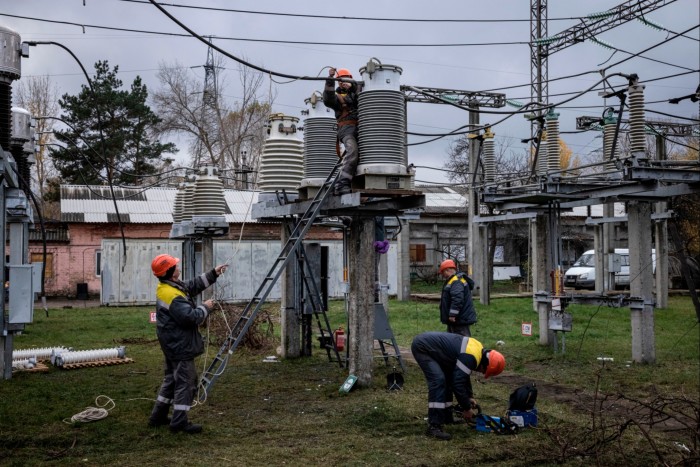
Ukraine is considering restarting electricity exports to EU countries after stabilising its own power network despite repeated Russian missile and drone attacks.
Although there are still power outages, the electricity situation has improved markedly since the beginning of the year, said Maxim Timchenko, chief executive of DTEK, Ukraine’s largest private power provider.
“We’re thinking about resuming exports of electricity for some hours [a day]” he said.
Russia in October began targeting Ukrainian power stations and grid infrastructure with almost weekly mass strikes, aiming to plunge the country into darkness during the winter.
Ukraine has lost half of its generating capacity over the past year to war damage or seizure by Russian occupying forces, and numerous substations and other grid infrastructure have been destroyed.
Timchenko said Ukraine no longer had a power deficit. He attributed the improvement to better air defence equipment and tactics, the fact that the country’s remaining nuclear and hydroelectric plants were operating at full load and recent sunny, mild weather aiding solar generation.
It was impossible to know whether the moment of maximum danger had passed because Russian president Vladimir Putin “could be crazy enough to attack a nuclear power station”, Timchenko added, but there was more confidence among the relevant Ukrainian parties about power stability.
Key dates in the war: Autumn 2022
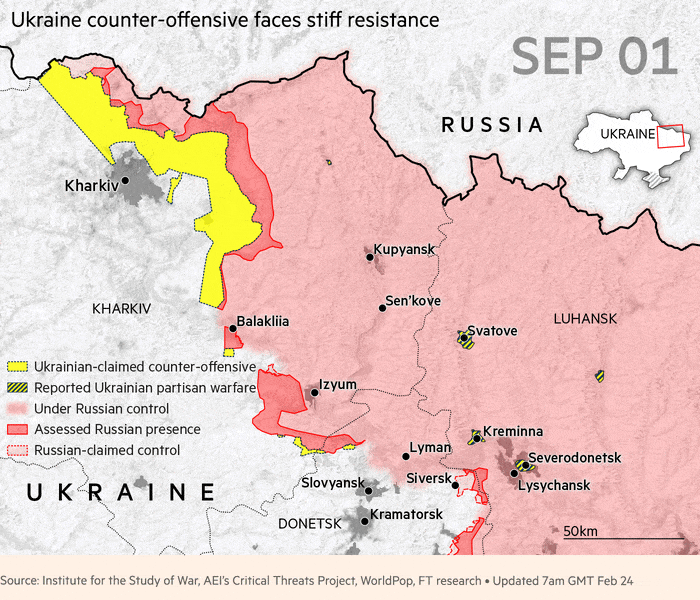
A lightning Ukrainian counter offensive in the north east of the country retakes swaths of territory from the Russians, including the city of Izyum. Russia lost 70km of territory in a single week before slowing the Ukrainian push down towards the end of the year.
Steve Bernard is the Financial Times’ senior visual journalist. He will be taking part in an “Ask Me Anything” on Reddit at 4pm GMT today to answer questions on how the FT has tracked Russia’s invasion of Ukraine in maps. Put your questions to him and read along here.
Insurers face stranded ships dilemma after a year of Ukraine war
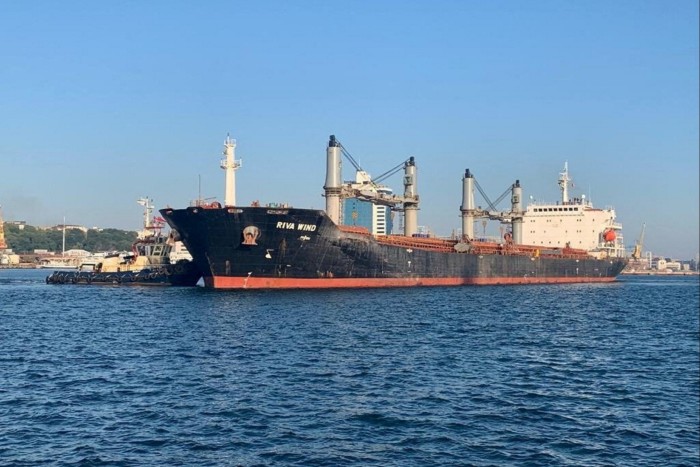
For insurers that have underwritten the tens of ships stranded as a result of the war in Ukraine, its first anniversary marks the point at which the vessels may become their problem.
Stranded ships can typically be declared a “constructive total loss” if not recovered after 12 months, meaning owners can claim the full insurance payout. Insurers can then take ownership of the vessel and sell it themselves to limit their losses.
Shipowners can keep their vessels in return for a smaller payout, but some owners are reluctant to keep ships that have been stranded at various Ukrainian ports since fighting broke out, leaving underwriters with a logistical headache.
“Unless an arrangement is made with current owners or a new buyer is found, these vessels will become the property of the underwriters by default,” said Mike Ingham, divisional director for marine insurance at broker Gallagher.
Market participants report a mini-flurry of deals with ships changing hands at steep discounts to their prewar value and buyers taking a punt that values will recover if the war abates.
Neil Roberts, head of marine and aviation at the Lloyd’s Market Association, which represents underwriters, said more than 60 vessels are stuck, citing maritime data.
US targets Russian banks and defence companies with latest sanctions
The US has taken aim at dozens of Russian banks and defence companies in its latest sanctions targeting the country’s military, industrial and financial sectors.
The Russian banks targeted by the US Treasury include Credit Bank of Moscow, Lanta Bank, Metallurgical Investment Bank, MTS Bank, Novosibirsk Social Commercial Bank and Bank Saint Petersburg, which the UK also put under sanctions.
The other targets were Bank Primorye, SDM-Bank, and Ural Bank for Reconstruction and Development, which is also under sanctions from the UK and Canada. In addition, the Treasury hit Bank Uralsib and Bank Zenit Public, both of which had sanctions imposed by the UK on Friday.
The Treasury also imposed sanctions on entities in the Russian metals and mining sector, including Burevestnik Central Scientific Research Institute, a Russian arms and artillery manufacturer, and OOO Metallurg-Tulamash, a steel manufacturer that the US says makes arms for the Russian navy.
“As the Ukrainian people continue to valiantly defend their homeland and their freedom, the United States is proud to support Ukraine through economic, security and humanitarian assistance,” US Treasury secretary Janet Yellen said. “Our actions today with our G7 partners show that we will stand with Ukraine for as long as it takes.”
Read more on the sanctions here.
Sweden to send 10 Leopard 2 tanks to Ukraine
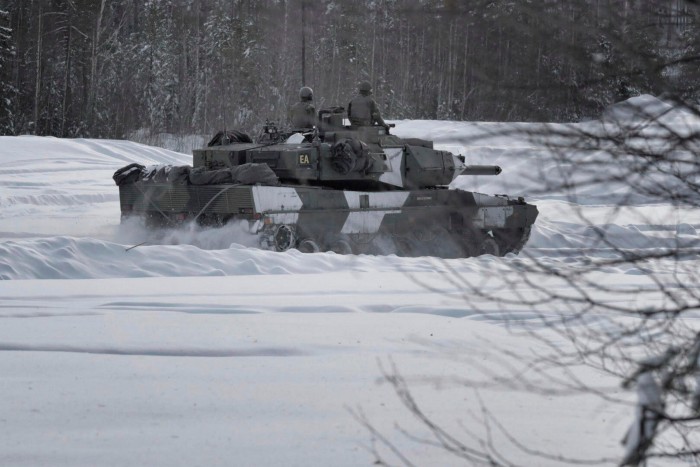
Sweden will send 10 Leopard 2 main battle tanks to Ukraine, as western efforts to provide Kyiv rapidly with heavy armour gather pace.
Defence minister Pål Jonson said on Friday that the 10 Leopard 2A5s, modern variants of the German-built main battle tanks, would be delivered “as soon as possible”.
“It is absolutely right to contribute with heavy weapons systems,” Jonson said. “It is crucial for Ukraine.”
Poland on Friday said the first of 14 Polish Leopard 2s pledged to Kyiv had arrived in Ukraine, while Germany said it would increase the number of Leopard 2A6 tanks it would send from 14 to 18. Spain on Thursday said it would provide six older Leopard 2s, but these would have to undergo extensive refurbishment.
The German government, which is spearheading efforts to assemble two battalions of Leopard tanks from various European armies, has expressed frustration that other capitals have hesitated to follow through on promises to provide tanks.
Sweden is also providing two air defence systems, including a state of the art IRIS-T battery, which has already proved highly effective in shooting down Russian missiles in Ukraine.
Key dates in the war: April 14 2022
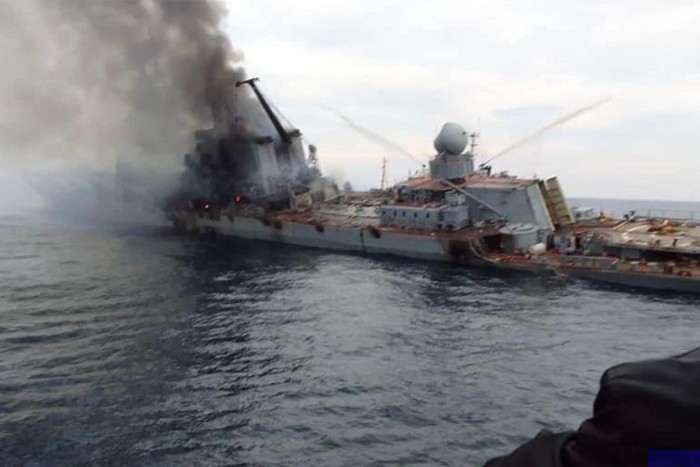
The Moskva missile cruiser, the flagship of Russia’s Black Sea fleet, sinks. Ukrainian officials said that the vessel had been hit by one of their anti-ship missiles, causing an explosion. The Russian defence ministry reported that the explosion was caused by a fire on board, which in turn set off ammunition stores. The sinking was a serious setback for the Russian navy.
Scenes from Ukraine: The generator anthem
Ukrainians call it the “generator anthem”: the hum of diesel-powered generators used to power their homes and businesses, and so thwart the power cuts caused by Russia’s missile and drone attacks on the country’s critical infrastructure.
I first heard it in Kyiv in January, three months after Russian forces started to systematically target the country’s electricity generation capabilities. Demand for imported generators and batteries is such that it even shows up on the national accounts.
The sound is unmistakable. It’s an aspect of the spirit of national resistance that impresses every visitor to Ukraine. It is also a showcase of the country’s talent for improvisation. How about this Tesla car owner, who used a portable generator to charge the battery-powered car. Genius!
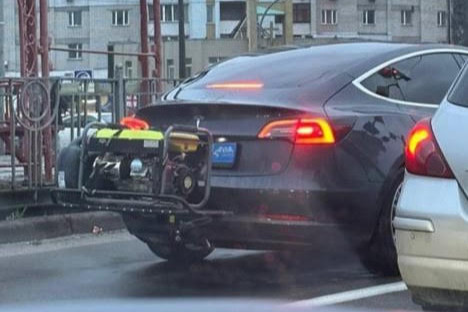
Oil price retreats from 2022 highs
The oil price has retreated one year on from Russia’s full-scale invasion of Ukraine, with Brent crude now back to similar levels seen at the beginning of last year.
The oil market took fright shortly after the start of the invasion in February 2022, because the risk was clear given that Russia was the world’s second-largest oil exporter.
Oil prices soon rose to $139 a barrel, the highest since the all-time peak of $147 a barrel in 2008. Diesel prices in particular soared, because Russia was the biggest external supplier of the refined fuel to Europe. Record prices on the forecourt soon followed.
But prices have retreated, largely as Russia has so far managed to maintain most of its oil exports to market by rerouting increasing volumes to Asia.
Western powers also tapped their strategic stockpiles to pour roughly 1mn barrels a day of extra supply into the market throughout last year.
Even supply cuts by Opec+ in October, which led the White House to accuse the cartel of in effect supporting Russia, only stopped prices from slipping lower.
The EU has now barred Russian seaborne imports and the G7 has tried to place a price cap on its crude and refined fuel exports, in a bid to keep its oil in the market while limiting the revenues flowing back to the Kremlin.
But so far the fallout for oil from the war in Ukraine has been much more limited than many had expected.
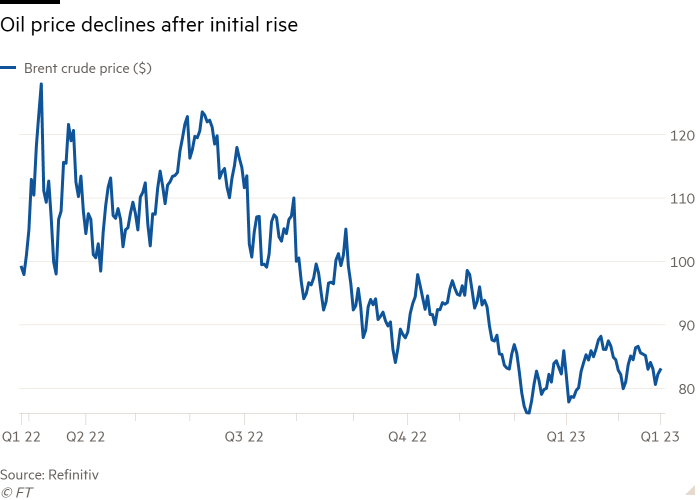
Key dates in the war: March 2022
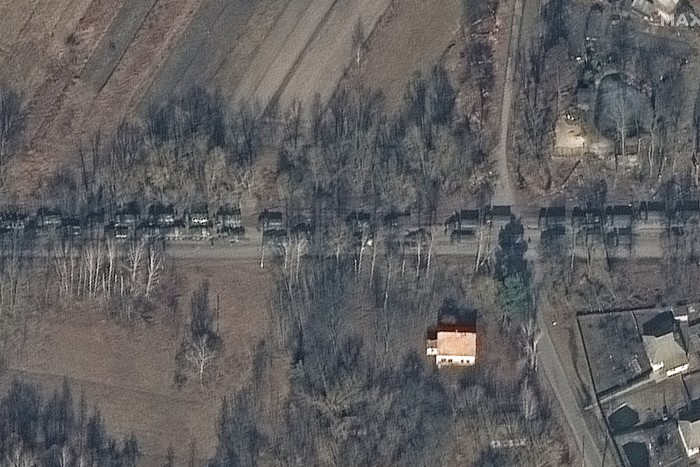
While artillery bombardments wrought huge damage in cities such as Mariupol and Kharkiv, a stalled Russian convoy 60km long north of Kyiv illustrated the Russians’ slow progress towards the Ukrainian capital. At the time, western intelligence officials said it was unclear whether Russia had not planned properly for the invasion in terms of logistical support, or whether it had difficulty executing its plan, partly because of stronger-than-expected resistance from Ukrainian forces.
Cities across the US to mark anniversary of Ukraine war
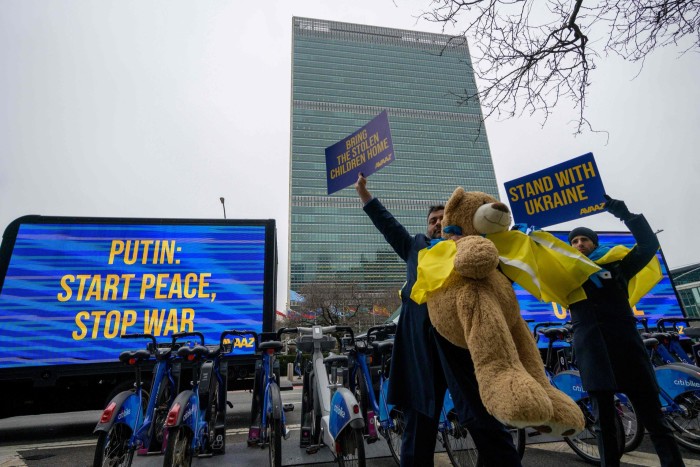
More than 35 cities and towns across the US are holding events marking the anniversary of Russia’s full-scale invasion of Ukraine.
US secretary of state Antony Blinken is in New York City for the UN Security Council ministerial meeting on Ukraine. There will be at least four grassroots events in New York City on Friday, according to the Ukrainian Congress Committee of America.
Klych, a group that supports Ukrainian culture, will host rallies in 16 US cities from Friday to Sunday, called 365 Days of Defending Freedom. One of the rallies will be in Chicago’s Ukrainian village, a neighbourhood with one of the highest concentrations of Ukrainian people in the US.
“For 365 days, [people] worldwide have rallied to support Ukrainians and call to action to help Ukraine,” Klych said in a Facebook post promoting a Friday event. “The support of the international community is crucial in helping Ukraine defend its independence and freedom.”
Chinese plan sends crucial signal on war stance
China’s 12-point plan for a Ukraine peace settlement has received a stony response from western leaders. Nonetheless, it sends an important signal about how Beijing intends to protect its interests as the war enters its second year.
The western response, set out by Nato chief Jens Stoltenberg and European Commission president Ursula von der Leyen, is that the Chinese plan lacks credibility because Beijing has refused to condemn Vladimir Putin’s invasion and lays much blame on the west for causing the war.
From a Chinese point of view, however, the plan suggests to the west that Beijing is serious about encouraging the Kremlin to find a political solution to end the war.
It appears significant that Chinese officials, when describing relations with Moscow, no longer use the phrase “no limits friendship” that was proclaimed by Putin and President Xi Jinping on the eve of the war a year ago.
China also appears determined not to let the war damage its extensive trade and investment relationship with the US and Europe.
Yet western governments note that China’s economic ties with Russia expanded in 2022, with a 43 per cent increase in Russian exports to China and a 13 per cent rise in Chinese exports to Russia.
China abstained on Thursday in a UN vote that condemned Moscow’s invasion by 141 votes to seven, with 32 abstentions.
‘This war has shredded Russia’s international reputation,’ says Blinken
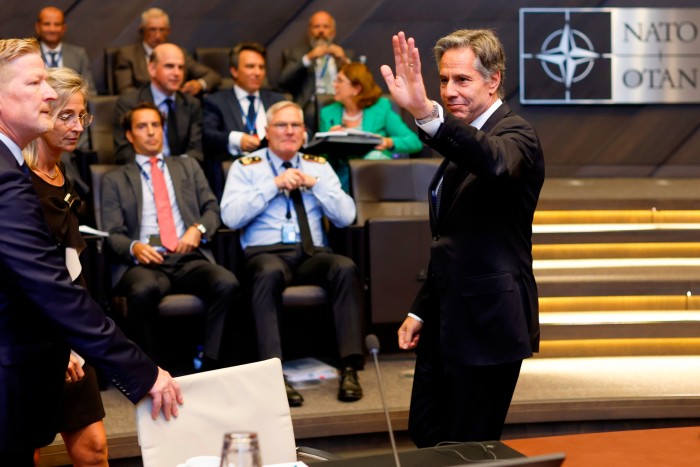
US secretary of state Antony Blinken emphasised Russia’s isolation and tattered reputation on the global stage as he pledged the US would stand with Ukraine until its “sovereignty is respected”, in a statement marking the first anniversary of the war.
“President Putin’s decision has ripped apart families, forced millions from their communities, destroyed homes, schools, hospitals, and other civilian infrastructure, exacerbated a global food crisis, destabilised energy markets and undermined international peace and security,” Blinken said on Friday.
Russia’s invasion has “needlessly” killed tens of thousands of people and brought harm to millions, the secretary added, after deceitfulness about why it was amassing soldiers on the Ukrainian border in the first place.
“This war has shredded Russia’s international reputation, left Russia weakened and isolated, and decimated its economy. This war is an attempt to seize territory from Ukraine and thwart its independent, democratic trajectory,” Blinken said.
He added that it was Putin who started this war “and he has the power to end it.”
“The United States stands strongly with Ukraine as it defends itself, and we will continue to do so until Ukraine’s sovereignty is respected and the people of Ukraine can shape their chosen, democratic future in freedom and peace.”
Key dates in the war: February 27 2022
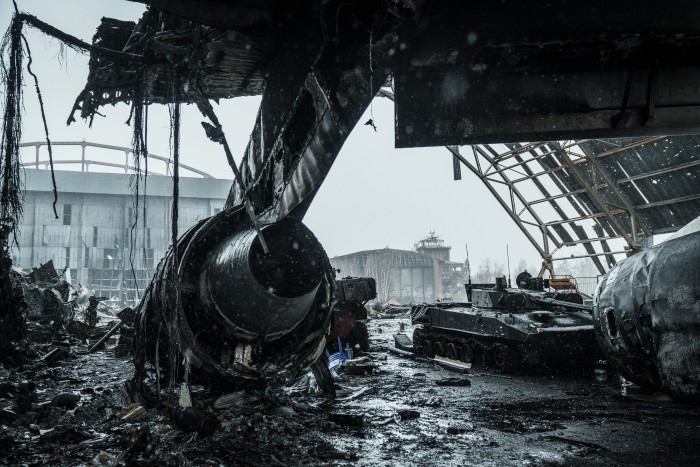
The battle for Hostomel airport. Ukrainian troops thwart a Russian airborne assault on a crucial airport north-east of Kyiv which would have served as a gateway for an attack on the capital.
Ukraine’s economy devastated by war
The war has had a devastating impact on the Ukrainian economy, which was already reeling from a succession of crises including Russia’s annexation of Crimea in 2014 and the Covid-19 pandemic. Ukraine’s GDP dropped 30 per cent in 2022.
Many of the country’s core industries have been hit hard. For example, two plants in Mariupol, which is now occupied by Russia, accounted for 40 per cent of Ukraine’s prewar steel output. The Russians have also bombed other heavy industry plants such as oil refineries.
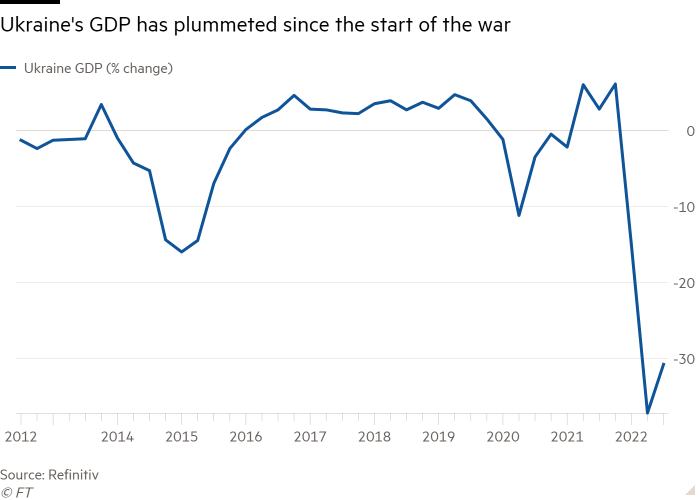
Russia’s effective blockade of the Black Sea has meant that it has been very difficult for the remaining factories working in Ukraine to export their goods, and for farmers to export their grain. So even those bits of Ukrainian industry and agriculture that are working normally have struggled to get their goods to market.
There is now a huge backlog of infrastructure that needs to be repaired and rebuilt, and it will probably take many months before that work even starts.
For more on Ukraine’s economy, listen to this week’s edition of the FT’s Behind the Money podcast.
FT live event: How long can Russia keep fighting the war in Ukraine?
The Financial Times is hosting a Twitter Spaces event to mark the first anniversary of Moscow’s full-scale invasion of Ukraine.
FT correspondents will answer your questions on the direction of the conflict as it enters its second year.
Join our Twitter Spaces event at 1pm GMT to participate.
Japan to propose new sanctions against Russia with G7 allies
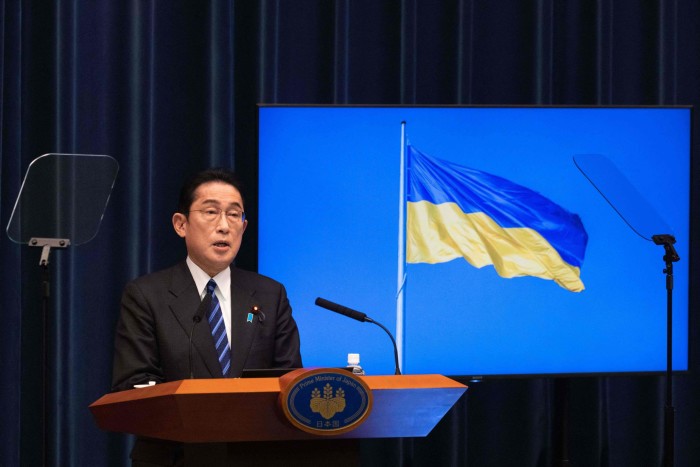
Prime Minister Fumio Kishida said on Friday that Japan planned to present new sanctions against Russia with other G7 countries in a show of solidarity on the first anniversary of Moscow’s full-scale invasion of Ukraine.
“We are thinking of presenting G7’s new stance on sanctions against Russia,” Kishida said ahead of a videoconference Japan will host with other G7 members and Ukraine’s President Volodymyr Zelenskyy later on Friday.
“In order to stop Russia’s invasion, it is important for the G7 . . . to confirm in today’s conference that we will continue to maintain and strengthen sanctions against Russia and support for Ukraine,” he added, without detailing the package of sanctions.
Kishida also said Japan, which is set to chair the G7 summit in May, would urge third parties to suspend military aid to Russia.
Following the start of the war in Ukraine, Tokyo ended its decade-long courtship of Moscow and rolled out tough measures against Russia despite initially struggling to keep up with western sanctions due to its reliance on Russian energy.
Key dates in the war: February 25 2022
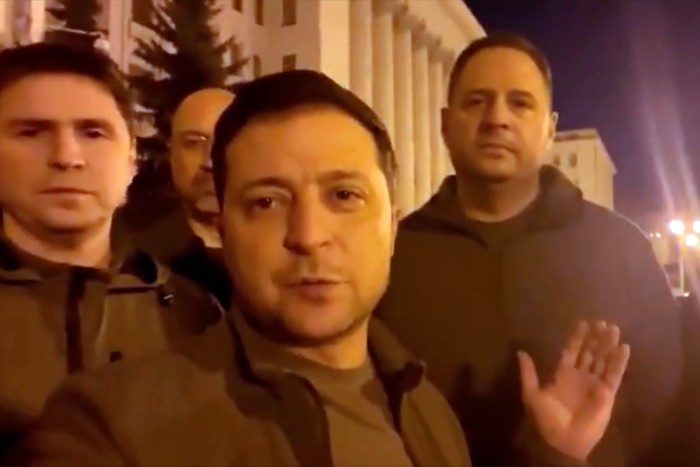
“We are here,” said Ukrainian president Volodymr Zelenksyy in a defiant video shot outside the presidential office, showing his determination to stay and fight despite the battle raging around him and potential threats to his own safety. Later that week, in response to western offers to evacuate him, he reportedly said: “I need ammunition, not a ride.”
US to impose fresh sanctions on hundreds of groups and individuals
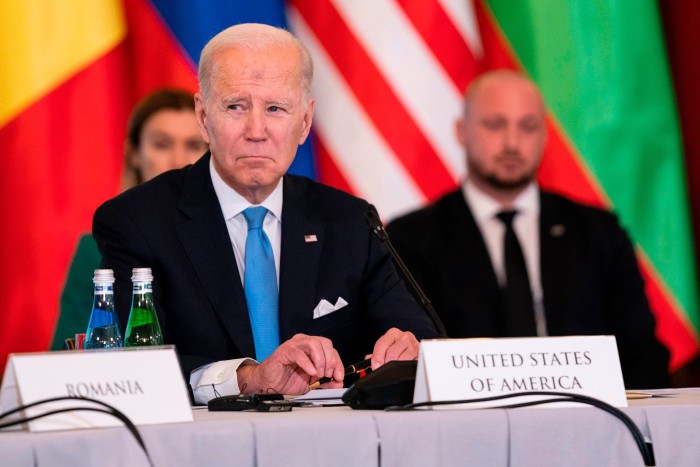
The US is to impose sanctions on hundreds of groups and individuals accused of assisting Russia’s war effort in Ukraine, as part of a G7 effort to increase pressure on Moscow on the anniversary of its full-scale invasion.
The White House said the sanctions, to be unveiled on Friday morning, would target more than 200 entities and people from Russia and countries in Europe, Asia and the Middle East. The measures will also include 12 Russian financial institutions and actors connected with Russian defence groups.
The Pentagon will also announce $2bn of new assistance for Ukraine, including unmanned aerial systems, electronic warfare detection equipment and ammunition for artillery and rocket systems. The package, which will come from US stockpiles, does not include longer-range missiles or advanced fighter jets, which Ukraine has sought. The US has committed more than $32bn in lethal assistance to Ukraine since Russia’s invasion.
In addition, US president Joe Biden will increase tariffs on some imports from Russia, a move “designed to target key Russian commodities generating revenue for the Kremlin while reducing US reliance on Russia”.
China ‘peace’ plan tainted by its support of Russia, say western officials
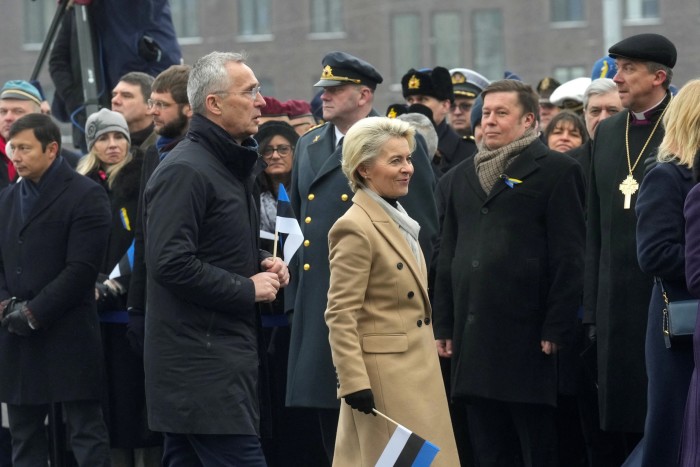
The heads of Nato and the European Commission have said that China’s proposed peace plan for Ukraine is tainted by its stance on Russia’s invasion of the country.
“We will look at the principles, of course, but we will look at them against the backdrop that China has taken sides,” said Ursula von der Leyen, commission president. “It is not a peace plan.”
“China has taken side[s] by signing for example an unlimited friendship [with Russia] right before the invasion,” she added.
“China does not have much credibility because they have not been able to condemn the illegal invasion of Ukraine,” said Jens Stoltenberg, secretary-general of Nato.
Both were speaking alongside Estonian prime minister Kaja Kallas during a joint visit to Tallinn on Friday.
Stoltenberg said there was no evidence China had supplied weapons to Russia, but there were signals it might. “We have not seen actual delivery of lethal aid, but what we have seen are signs and indications that China may be planning and considering to supply military aid to Russia,” he said.
“China should not do that, because that would be to support an illegal law of aggression and breach international law.”
UK defence secretary hints at new impetus to supply fighter jets to Ukraine
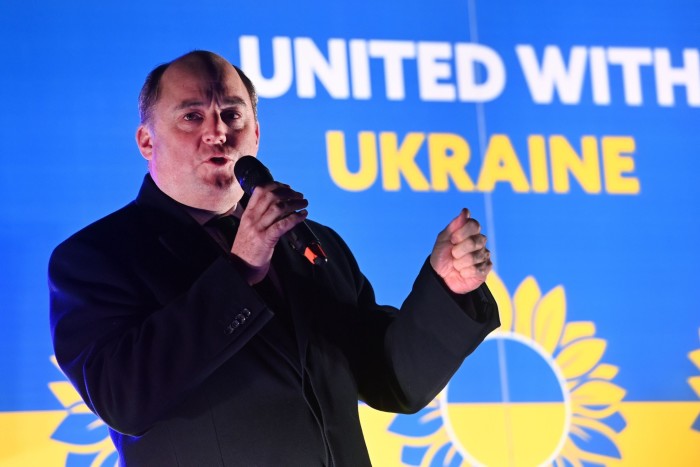
UK defence secretary Ben Wallace has given the strongest indication yet that the UK could co-operate in plans to supply Soviet-built fighter jets to Ukraine.
Wallace was speaking as former prime minister Boris Johnson continued to push for the UK to supply some of its own Eurofighter Typhoon aircraft to Kyiv, a plan that the UK government has suggested would be impractical.
Wallace told BBC Radio that providing fighter jets was “complicated” and that countries supplied with an aircraft type also needed to know how to fight with it — which he said could take years to learn.
However, Wallace sounded positive about the possibility that an aircraft such as Soviet-built MiG fighters could be supplied to Ukraine from a Nato member such as Poland, while UK aircraft such as the Typhoon were sent either for Poland’s own use or for operation by the RAF over Poland.
Wallace said such an arrangement was “definitely always on offer”.
“If a country approaches us and says, ‘We’d like to do that’, the United Kingdom would be very happy to either backfill or indeed cover with things like extra cover by our Typhoons for air policing and protection,” Wallace said.
Grain price jitters for traders on Black Sea grain deal renewal
International traders are focused on the extension of the Black Sea grain export deal between Kyiv and Moscow due to expire next month, amid Ukrainian accusations that Russian inspectors were deliberately delaying the transit of grain ships in the port of Istanbul.
The agreement, brokered by Turkey and the UN last July, allowed Ukrainian grain shipments to flow through the Black Sea, subduing prices, which hit peaks around May. Grain prices have since fallen to pre-war levels although they remain at historically high levels.
Ukraine had been a leading player in the global food commodity markets prior to the war, accounting for about 10 per cent of the global wheat export market, just under half of the sunflower oil market and 16 per cent of the corn market.
Last November, the deal was extended despite President Vladimir Putin’s threats to terminate the agreement, and there is heightened uncertainty over how Moscow will act at the negotiation table.
“If [the deal] is renewed that’s great news but if it’s not done, then immediately you’re going to have an issue there with supplies,” warned John Baffes, senior agricultural economist at the World Bank. “Those issues are going to affect mostly countries in North Africa and the Middle East,” he said.
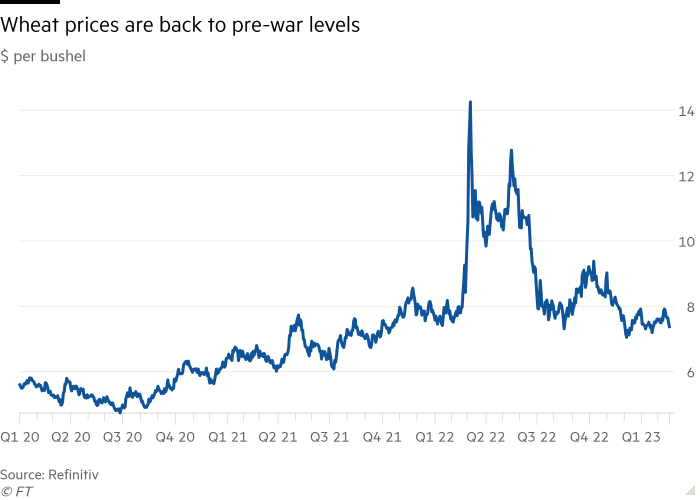
Scenes from Ukraine: Arrival in Lviv
It was my arrival in Ukraine that really stuck in my memory — the scene of panic and chaos in Lviv railway station. I arrived before dawn on Saturday February 26 last year, less than two days after the start of war, and the place was seething with refugees from the east. People weighed down with luggage and pets in baskets crowded the platforms and corridors, waiting anxiously for trains heading to Poland.
It was dark and cold, and my walk to the centre of town was accompanied by the wail of air raid sirens. It’s a sound that strikes a deep fear in you when you’re walking alone down an ill-lit street in a country that’s just been invaded. There was no sign of bunkers or air raid shelters to hide in: I sought shelter in the entrances of buildings, but they offered little protection.
It was nearly as bad when I reached my hotel in central Lviv, the Plazma — a name that conjured up both glitz and field hospitals. It was a kind of B&B on the fourth floor of a four-storey building. My room was in a crow’s nest at the top, and every time the sirens started we’d have to run down four flights of stairs (there was no lift) to the building’s cellar, a dark, labyrinthine place with nowhere to sit and barely enough room to stand. Lviv, in wartime, a whole city tensed in fear of Russian missiles, cowering in bunkers, contemplating a life turned upside down.
The war in maps
The first stage of the war was marked by Russian advances on several fronts in the north, east and south of Ukraine. However, as the year wore on, Russia focused its efforts on the east of the country as Ukraine pushed the invading forces back.
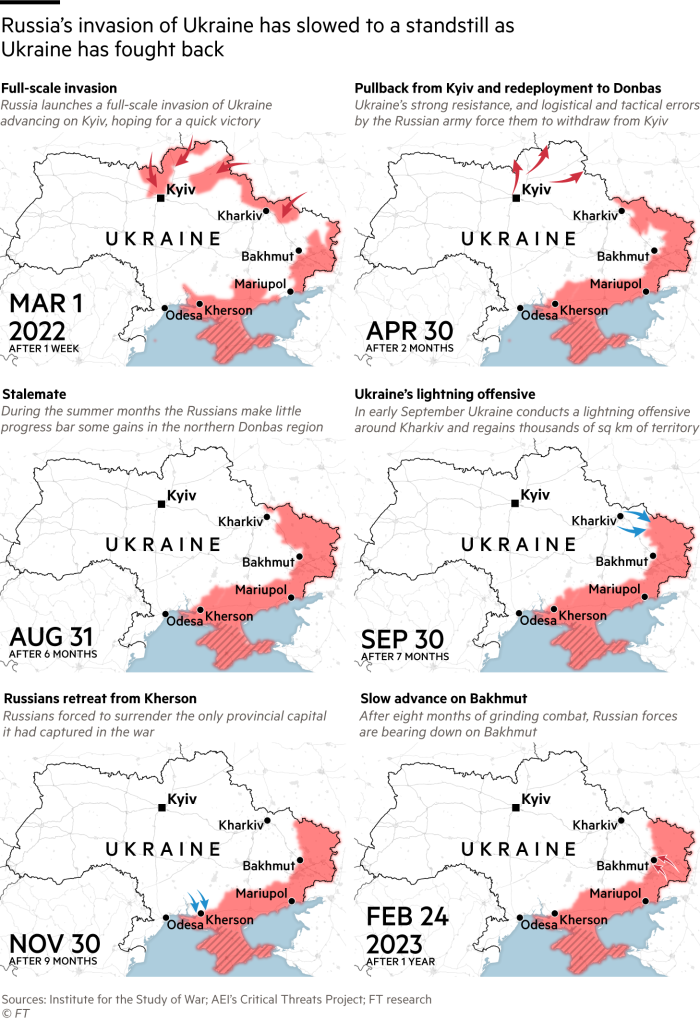
For more maps on the Ukraine war, click here.
Spring battles will be ‘decisive’, says Ukraine’s military intelligence chief
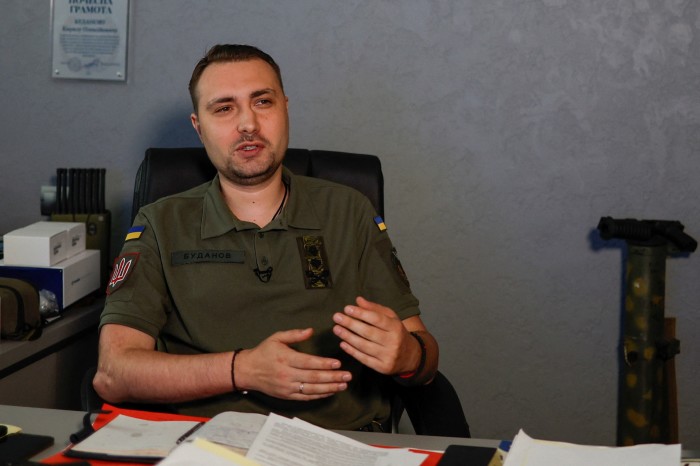
Major General Kyrylo Budanov, Ukraine’s military intelligence chief, has said that battles waged this spring are likely to decide the outcome of Russia’s war against his country.
“From the middle to the end of spring there will be decisive battles,” Budanov said in interviews with Forbes Ukraine and Ukrainska Pravda ahead of the first anniversary of Russia’s full-scale invasion of Ukraine. He added that these battles would mark a major “turning point” in the war, which has caused tens of thousands of civilian and military casualties and the destruction of entire cities and towns.
Budanov, who was the only government official in Kyiv to boldly and publicly predict Russia’s full-scale invasion, also claimed the war would end this year. “The score is 1-1, and the minute is 70,” Budanov said, using a football analogy to explain his belief that the war is nearing an end.
But what kind of end remains unclear. He echoed President Volodymyr Zelenskyy in saying that Ukraine would accept nothing less than the full restoration of its territorial integrity, which would mean recapturing all of the eastern and southern provinces of Ukraine occupied by Russia, including Crimea.
Ukraine has said it plans to launch a major counteroffensive in the spring to liberate areas under Russian occupation.
Russia’s goal, said Budanov, is to capture all of the Donetsk and Luhansk provinces by March 31. Russian president Vladimir Putin claimed to have “annexed” those provinces along with the southern regions of Zaporizhzhia and Kherson in September.
The first 24 hours, part 2: The start of the invasion
Vladimir Putin’s announcement of a “special military operation” in Ukraine marked the start of a full-scale invasion, prompting Ukraine’s army to mobilise.
03:00 (GMT): In a televised address, Russian president Vladimir Putin ordered a “special military operation” in eastern Ukraine’s Donbas region. He requested Ukrainians lay down their weapons, claimed he was not planning to occupy the country, and warned others that meddling would “lead to consequences that you have never encountered in your history”.
07:00: Ukrainian president Volodymyr Zelenskyy said that martial law would be imposed as he condemned an “unjustified, deceitful and cynical invasion”.
09:00: Ukraine’s cities, airports and military infrastructure were bombed by Russia’s armed forces. Ukraine’s army said it had regained control of the eastern city of Mariupol after heavy fighting, while battles continued around Kharkiv.
14:00: Hundreds of cars queued at borders, in what marked the start of an exodus of millions of refugees to Nato member countries bordering Ukraine.
16:00: In a televised speech, Zelenskyy urged the “leaders of the free world” to help Ukraine with financial and military support, and appealed to Russians to protest against the war and ended his address saying that “Ukraine proposes to return to the path of peace”.
23:00: Zelenskyy ordered a “general mobilisation” of men in Ukraine and said the country had lost the lives of at least 137 armed forces servicemen on the first day of the war.
Nato restates support for Kyiv’s ‘heroic defence of their nation’
Nato has restated its support for Ukraine in a declaration from all of the military alliance’s 30 members vowing to “maintain our support for as long as necessary to help Ukraine prevail”.
The defence bloc said in its statement: “We as allies reaffirm our solidarity with the government and people of Ukraine in the heroic defence of their nation, their land and our shared values.”
The statement was also endorsed by Finland and Sweden, which are in the process of becoming Nato members.
“Russia’s efforts to break the resolve of the brave people of Ukraine are failing. One year on, Ukrainians are fighting valiantly for freedom and independence. We stand with them,” the alliance said.
Nato also said that Russia’s invasion “threatens global security” and that President Vladimir Putin’s use of nuclear threats “demonstrates clearly Russia’s disregard for international norms and the welfare of billions of people around the world”.
UK unveils fresh package of sanctions against Russia
The UK government has announced a fresh package of sanctions against Russia on the first anniversary of Moscow’s full-scale invasion of Ukraine, which will ban the export of every item Russia is using on the battlefield.
The measures are aimed at further turning the screws on Russia’s military-industrial complex, which intelligence has shown is already being hampered by international sanctions.
UK foreign secretary James Cleverly said: “Ukrainians are turning the tide on Russia, but they cannot do it alone. That is why we must do more to help Ukraine win.”
The sanctions also target senior executives at Russian state-owned nuclear power company Rosatom, which the British government said has close connections to Russia’s military machine and President Vladimir Putin’s administration.
In an effort to further isolate Russia from the international financial system, four banks are also being hit with sanctions. The measures will also ban the import of goods including iron and steel products processed in third countries.
Kemi Badenoch, the UK’s business and trade secretary, said: “Trade sanctions are working. UK goods imports from Russia have fallen by 99 per cent since before the invasion, and goods exports to Russia have fallen by nearly 80 per cent.”
Global hunger jumps as Ukraine war pushes up food prices
Global hunger jumped by almost a quarter last year to a record 349mn people as the Ukraine war sent food prices soaring.
Acute food insecurity, when a person’s life or livelihood is in immediate danger due to the lack of food, jumped 23 per cent from the previous year and 2.6 times from pre-pandemic levels, according to the UN World Food Programme.
Arif Husain, WFP’s chief economist, said he was pessimistic about the global food security outlook. “The food security situation of the world has been continuously going from bad to worse and doesn’t stop,” he said.
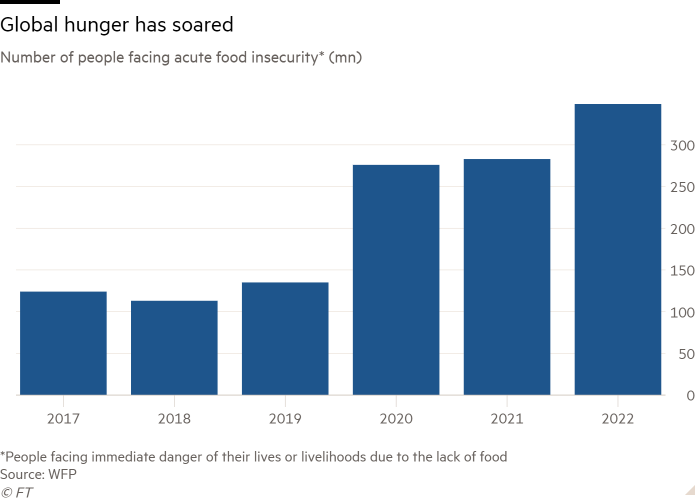
The Ukraine war hit an already deteriorating global food security situation due to the Covid-19 pandemic. Food and fertiliser prices have retreated from last year’s peaks but they are still high, leading to elevated prices for consumers, especially those in low income countries, said Husain.
Wheat is trading at about $7.40 a bushel, about a third higher than at the end of 2019, while corn is 75 per cent higher at about $6.80 a bushel. The last time prices were at these levels pre-pandemic was in 2013 after a severe drought in the US.
Zelenskyy marks ‘year of pain, sorrow, faith and unity’ in defiant address
President Volodymyr Zelenskyy vowed to defeat Russia in 2023, as Ukraine marked the solemn anniversary of the start of Russia’s full-scale invasion and a year that forever altered the country and upturned the global order.
“A year ago on this day, from this same place around seven in the morning, I addressed you with a brief statement, lasting only 67 seconds,” the president said in a morning address, recalling his dawn speech delivered as bombs fell across Ukraine on February 24 2022.
“Two of the most important things both then and now echoed . . . The fact that Russia started a full-scale war against us. And that we are strong. We are ready for anything. We will defeat everyone. Because we are Ukraine!”
In his anniversary address, Zelenskyy called last February 24 “the longest day of our lives. The most difficult day in our recent history. We woke up early and haven’t slept since.”
The past 365 days, he said, were “a year of resilience. Year of courage. A year of pain. A year of hope. A year of aging. A year of unity. The year of invincibility.” As the war enters its second year, the Ukrainian president said that “our victory is inevitable. It is close. It will happen.”
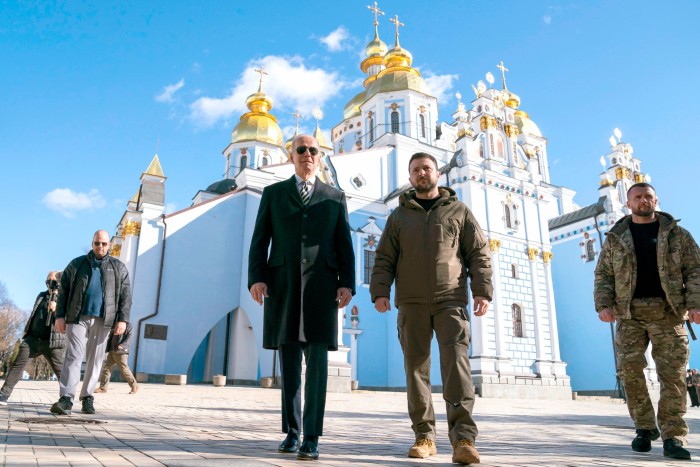
Speaking defiantly from his presidential office dressed in a black sweatshirt adorned with a golden trident, Ukraine’s coat of arms, he said Ukrainians “did not raise the white flag, but began to defend the blue-yellow one” when the invasion broke out.
Ukrainians “weren’t scared, didn’t break down, didn’t give up”, Zelenskyy said. He recalled the acts of defiance that defined the first hours of Russia’s invasion, including the famous retort from Ukrainian border guards on Snake Island to the demand of Russia’s Moskva missile cruiser for them to surrender.
The border guards’ response, “Russian warship, go f*** yourself!” became a battle cry that would reverberate across the world and inspire Ukrainian resistance.
Zelenskyy underscored the fact that Russia’s attempt to subjugate Ukraine began not one year ago, but in spring 2014. “Nine years ago, our neighbour became an aggressor. A year ago, the aggressor became an executioner, looter and terrorist. We have no doubt that they will be held accountable,” he said.
A busy week in Kyiv for Zelenskyy
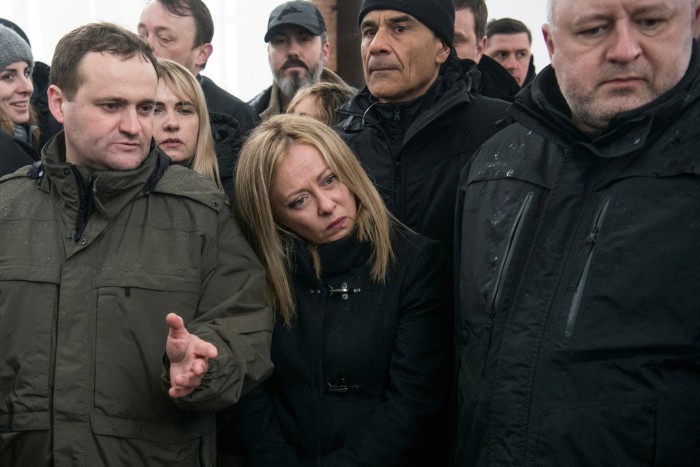
Ukrainian leader Volodymyr Zelenskyy has had a busy week in Kyiv, welcoming a variety of world leaders who have come to show their support.
Joe Biden was first up. The US president made a surprise visit to the Ukrainian capital on Monday ahead of a trip to Poland. “I’m here to show our unwavering support for the nation’s independence, sovereignty and territorial integrity,” Biden said. He also promised another $500m in military aid.
Next came Italian prime minister Giorgia Meloni who visited on Tuesday. She warned that a Russian victory in Ukraine could encourage Moscow to undertake further aggressions against Europe, as she pledged to maintain Italian support for Ukraine’s effort to defend itself.
Then on Thursday it was the turn of Spanish prime minister Pedro Sánchez. “We will stand by Ukraine and its people until peace returns to Europe,” he said in a tweet.
The first 24 hours, part 1: The lead-up to the invasion
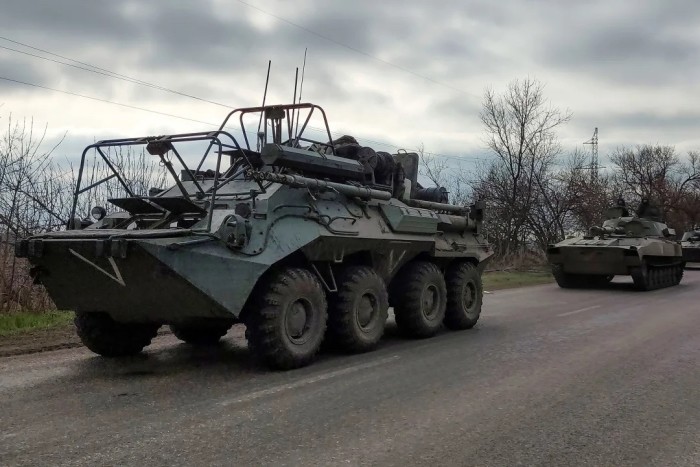
Almost 200,000 Russian troops and thousands of armoured vehicles were circling Ukraine in the early hours leading up to Russia’s invasion and the outbreak of the war on February 24 2022.
23:00 The Kremlin said that leaders of Moscow-backed separatist territories of Donetsk and Luhansk in eastern Ukraine had asked Russian president Vladimir Putin to “repel the aggression of the Ukrainian regime”.
23:00 Ukraine’s foreign minister Dmytro Kuleba said the country had requested an emergency meeting of the UN Security Council.
23:00 Ukrainian president Volodymyr Zelenskyy made an emotional televised speech urging Russians not to believe claims that Ukraine supports Nazism, in a bid to prevent the outbreak of a war.
01:00 US secretary of state Antony Blinken told NBC News that he believed Russia was going to launch a “major aggression” against Ukraine before the end of the night.
03:00 UN secretary-general António Guterres appealed directly to Putin to prevent troops from attacking Ukraine. “Give peace a chance,” he said at the UN Security Council emergency meeting.
Times refer to publication at Greenwich Mean Time on the FT’s live blog on the first day of the war in Ukraine.
Russia’s nuclear treaty move raises risk of new arms race
Vladimir Putin’s decision to suspend Russia’s participation in the last remaining arms control agreement with the US has increased fears over uncontrolled nuclear proliferation and a potential new arms race.
Moscow’s move would leave a number of deployed US and Russian nuclear warheads unchecked for the first time in over half a century, raising concerns about other emerging nuclear powers such as China having few incentives to adhere to a global arms control regime.
Rose Gottemoeller, a former deputy secretary-general of Nato and previously the US chief negotiator on the so-called New Start treaty, said Russia’s suspension was a “disaster” for arms control.
“So what does Putin think he’s going to accomplish by essentially launching an arms race with two major economic and industrial powers?” she asked, noting that Russia’s capabilities would be far outstripped in such a scenario.
Gottemoeller said it was “dangerous” for Moscow to abandon the New Start framework just when the US was beginning to upgrade its nuclear weapons and China was working on its own modernisation programme.
Read more about Russia’s nuclear treaty moves.
China calls for ceasefire with plan unlikely to win backing from Kyiv
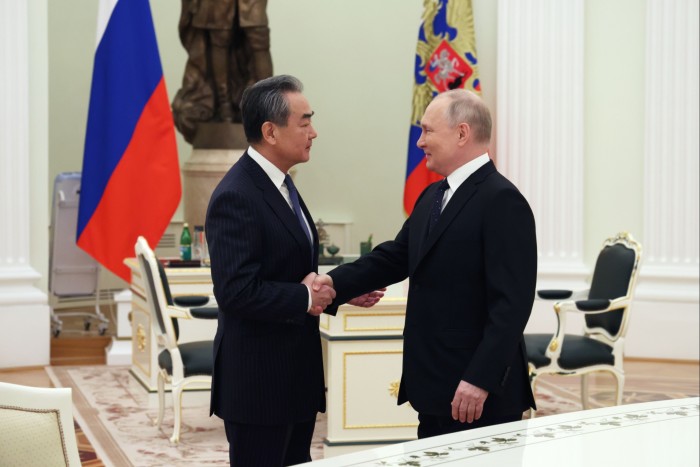
China has called for a ceasefire in the war in Ukraine and a return to negotiations as Beijing attempts to position itself as a peacemaker in the conflict on the anniversary of Russia’s full-scale invasion.
The Chinese foreign ministry on Friday released a 12-point plan for the “political settlement” to the war in Ukraine, though many of the measures reiterated Beijing’s standard talking points on the conflict.
Chinese diplomats have engaged in a difficult balancing act over the war, straining to appear neutral despite its close ties to Moscow while blaming Washington and Nato for provoking the conflict.
“Dialogue and negotiation are the only viable solution to the Ukraine crisis,” the foreign ministry said. “All efforts conducive to the peaceful settlement of the crisis must be encouraged and supported.”
Beijing’s call for a ceasefire is unlikely to receive support in Kyiv until Russia withdraws from huge swaths of territories it has occupied, an issue that was not addressed in the 12-point position paper.
Read more about China’s plan.
UK’s Cleverly to pledge support for Kyiv for ‘as long as it takes’
UK foreign secretary James Cleverly will on Friday pledge to support Ukraine for “as long as it takes”, in an address to the UN Security Council to mark the first anniversary of the conflict.
Cleverly will meet Ukrainian counterpart Dmytro Kuleba in New York alongside António Guterres, the UN secretary-general, to discuss the UK’s support to Kyiv and the region’s long-term stability.
“One year into this terrible war, let us send this clear message: Our support for Ukraine is not, and will never be, time-limited,” Cleverly is expected to say. “We will keep the promises we made to the UN Charter and the Ukrainian people. And will give the Ukrainians all the help they need. For as long as it takes. Until Ukraine prevails.”
Commenting ahead of his visit, Cleverly argued that Russian President Vladimir Putin had been “proven greatly wrong” in his assumption that Ukraine would “crumble within weeks”
“Twelve months on, the international community remains resolute that Ukraine will win the war, end Russia’s threat to Ukraine’s sovereignty and forge a sustainable peace,” he added. “Ukraine is turning the tide and Putin is losing. One year into this terrible war, our support will continue for as long as it takes.”
The war in Ukraine — one year since Russian tanks rolled across the border
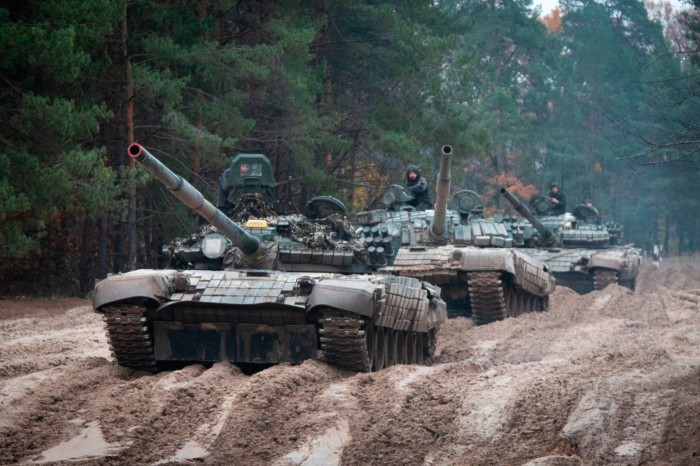
Welcome to the Financial Times’s live coverage of the first anniversary of the war in Ukraine. On February 24 last year, the world awoke to news that Russian tanks had rolled into Ukraine from the east and north.
Troops had been massing on Ukraine’s borders for months and Russian leader Vladimir Putin had made a series of fiery speeches on the long-running conflict in the Donbas region.
There were fears that the war could be a short one, with Ukrainian troops potentially overrun in a matter of days. But that has not proved to be the case.
Stay with us as we take you through all the key points of the past year, look at the impact of the conflict around the world, and bring you all the latest developments on the ground.
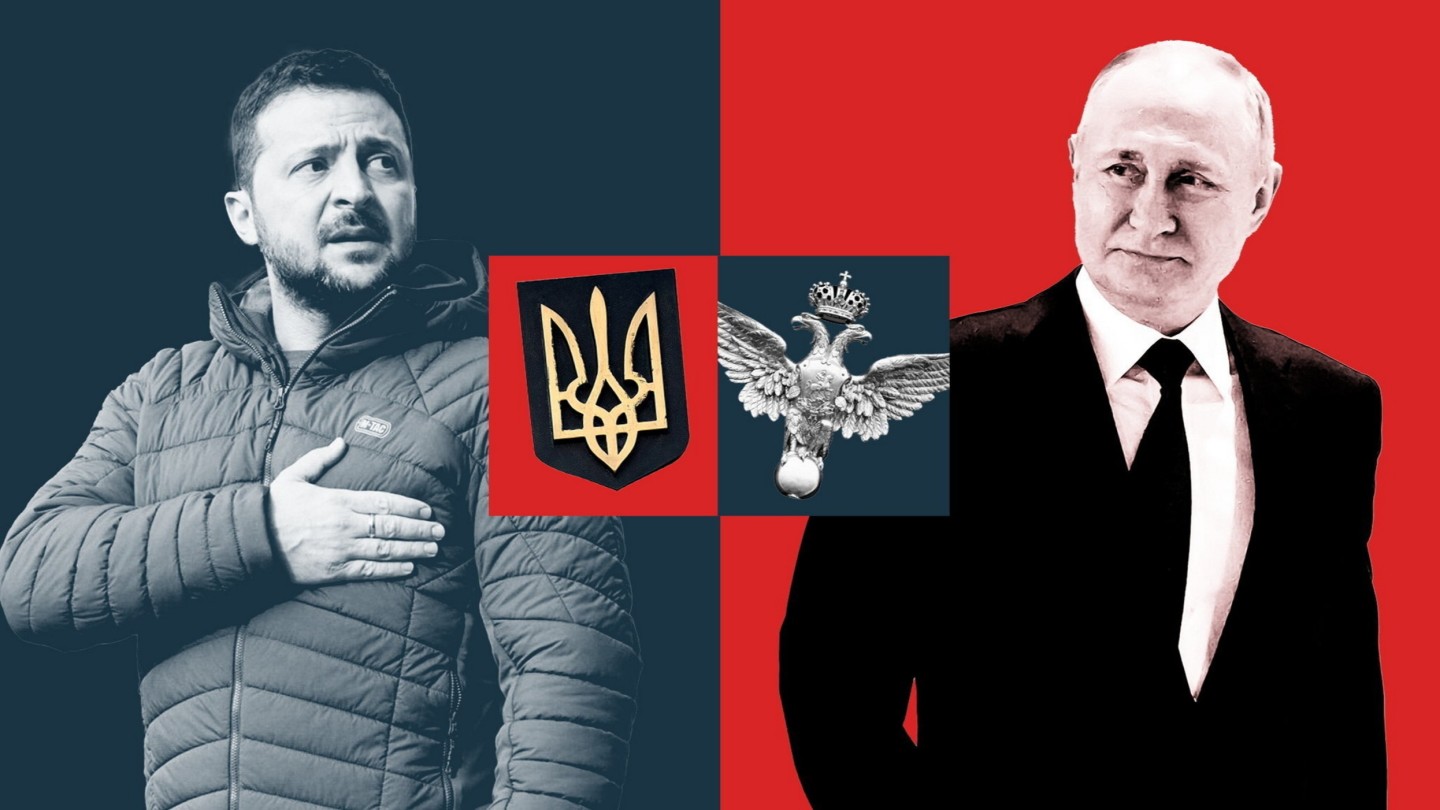
Comments